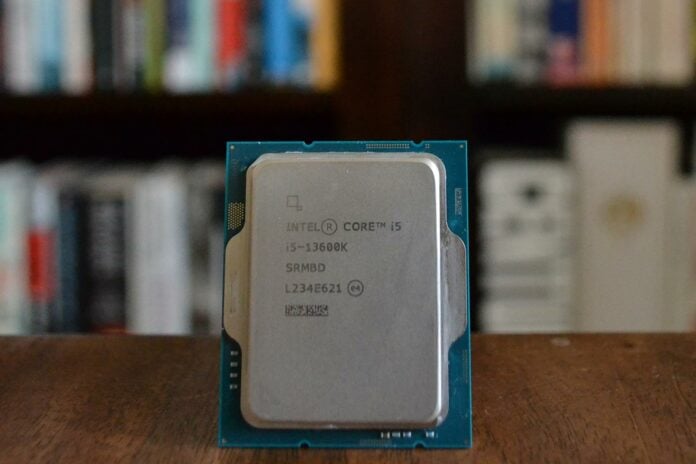Intel unleashed 13th Gen Core Raptor Lake processors late last week. Armed with more cores, cache and frequency than 12th Gen Alder Lake chips, range-heading Core i9-13900K took it to AMD’s recent Ryzen 9 7950X in the high-end stakes. Practically as fast in multi-core applications and a clear winner in gaming, there’s a lot to like about Intel’s champion desktop processor of 2022. Yet it’s not our favourite, and the stiffest competition comes from Intel’s very own Core i5-13600K – a snarling wolf in sheep’s clothing.
Before we jump to what makes the chip so great, first a recap on all things Raptor Lake. Understanding the architecture provides a solid framework for interpreting the oh-so-impressive results.
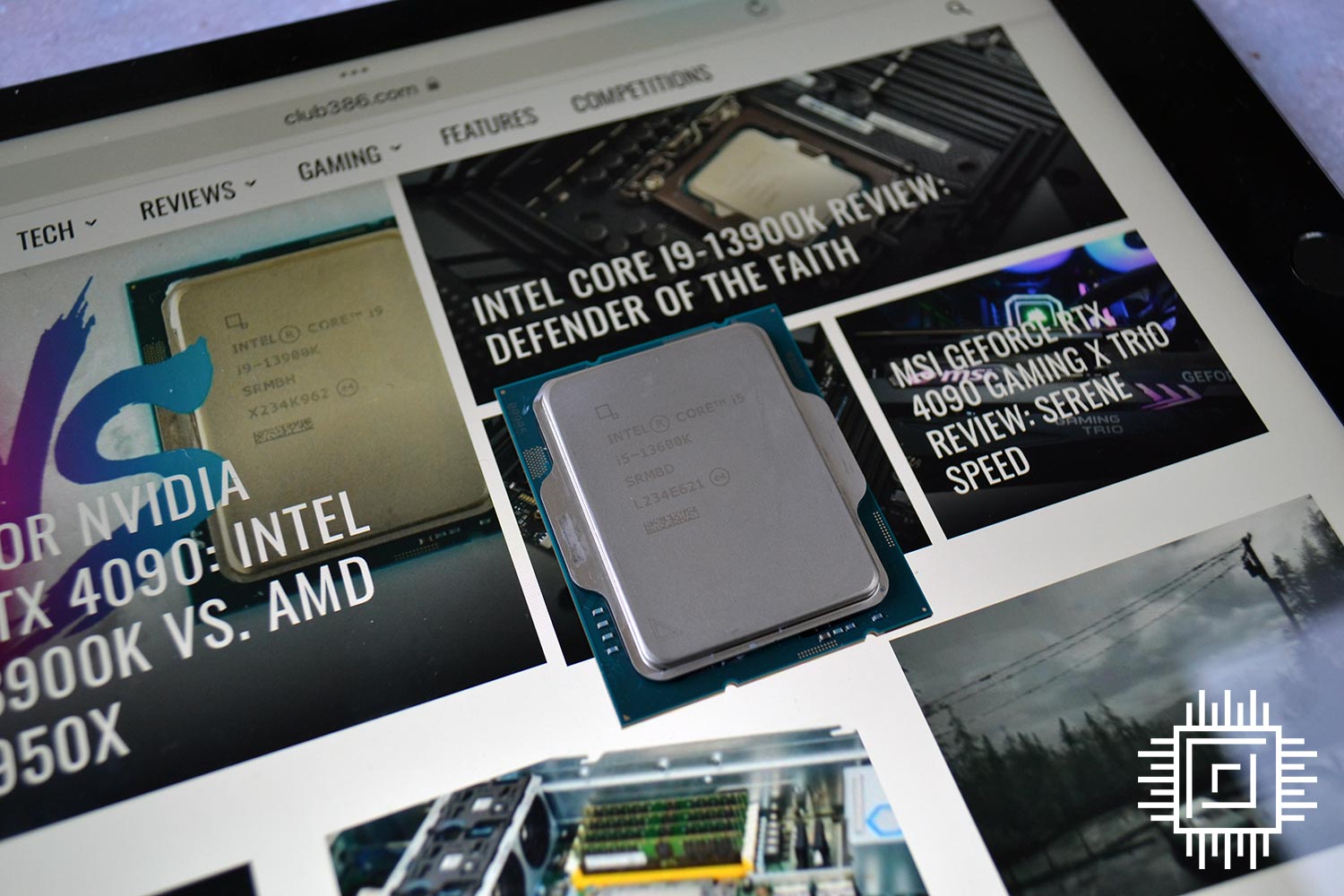

Intel Core i5-13600K
£299 / $319
Pros
- Excellent performance
- Great value
- Superb gaming
- Wide compatibility
- DDR4/DDR5
Cons
- No cooler included
Club386 may earn an affiliate commission when you purchase products through links on our site.
How we test and review products.
Appreciating 13th Gen Core uses the same hybrid-architecture as its immediate predecessor, it’s illuminating that performance gains are achieved without moving from the Intel 7 10nm Enhanced SuperFin process used on Alder Lake.
Alder Lake On Steroids
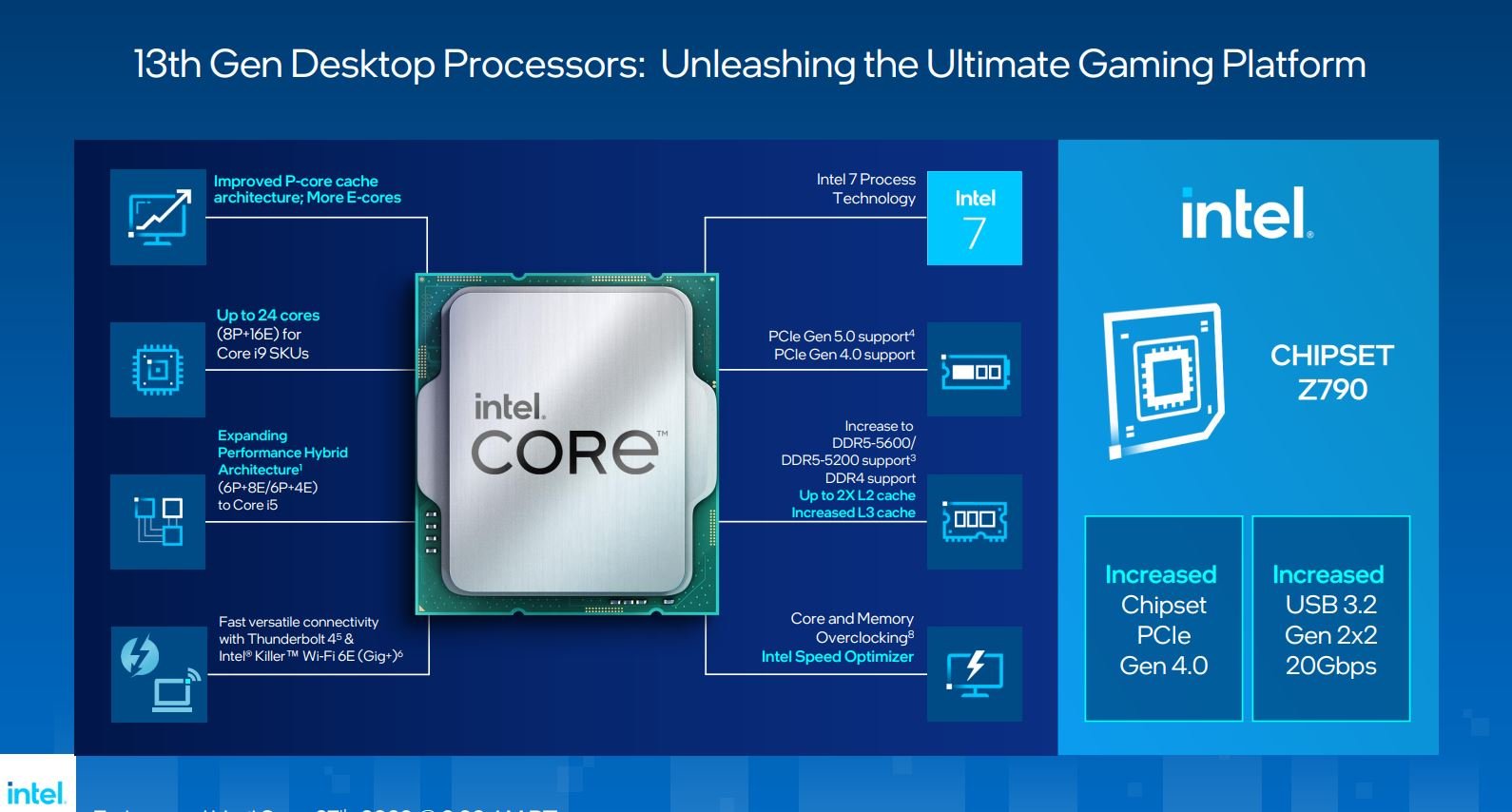
Looking at the wider introduction first, Intel is adding more E-cores for Core i5, Core i7 and Core i9 families, translating to greater processing power across the entire stack. On top of that, the hybrid memory controller is now specified for native operation at DDR5-5600 speeds, up from DDR5-4800 on 12th Gen Core.
Intel has already announced 700 Series chipsets to fully support 13th Gen Core processors. Flagship Z790, however, doesn’t differ much from today’s Z690, which will also support Raptor Lake processors through a BIOS update.
Moving with the times, chipset PCIe 3.0 lanes are reduced from 16 to 8, while 4.0 lanes conversely rise from 12 to 20, primarily to service high-speed expandability for peripherals hanging off the PCH. There’s a further USB 3.2 2×2 20Gbps port, as well, but that’s your lot.
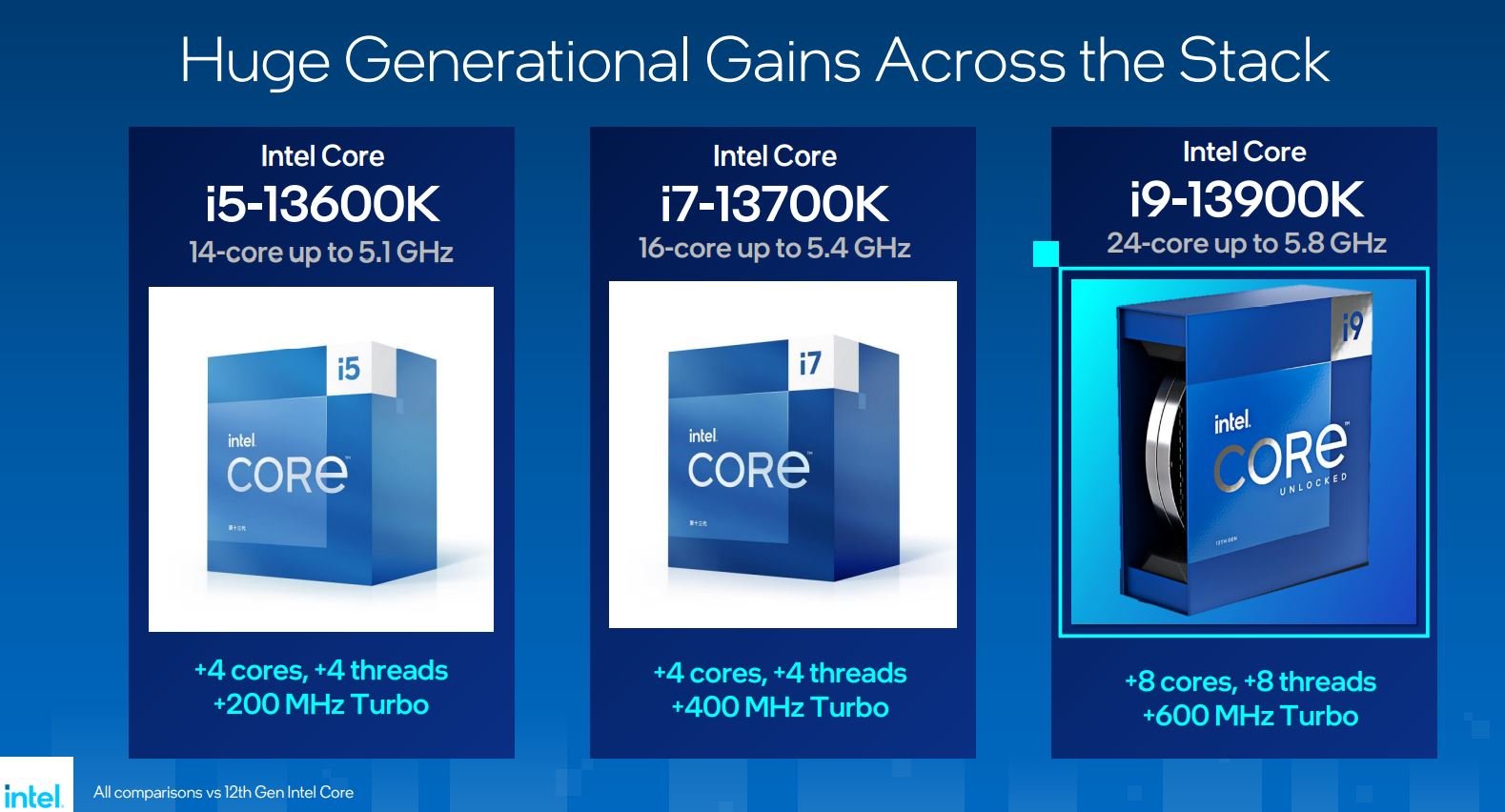
Fuelling Performance Through More Cache
Intel comments it’s been able to boost Raptor Lake frequencies by using an improved version of third-generation Intel 7 process. Like latest Ryzens, this shifts the voltage/frequency curve out by a reasonable amount.
13th Gen Core can run at the same speed as 12th Gen Core with 50mV less juice – leading to the appetising idea of heaps of performance at reduced TDPs – or offer an additional 200MHz at the same voltage. Cranking out more speed with an expanded TDP range is how the newest Core i9 scales up to 600MHz higher, which is a key weapon in its arsenal.
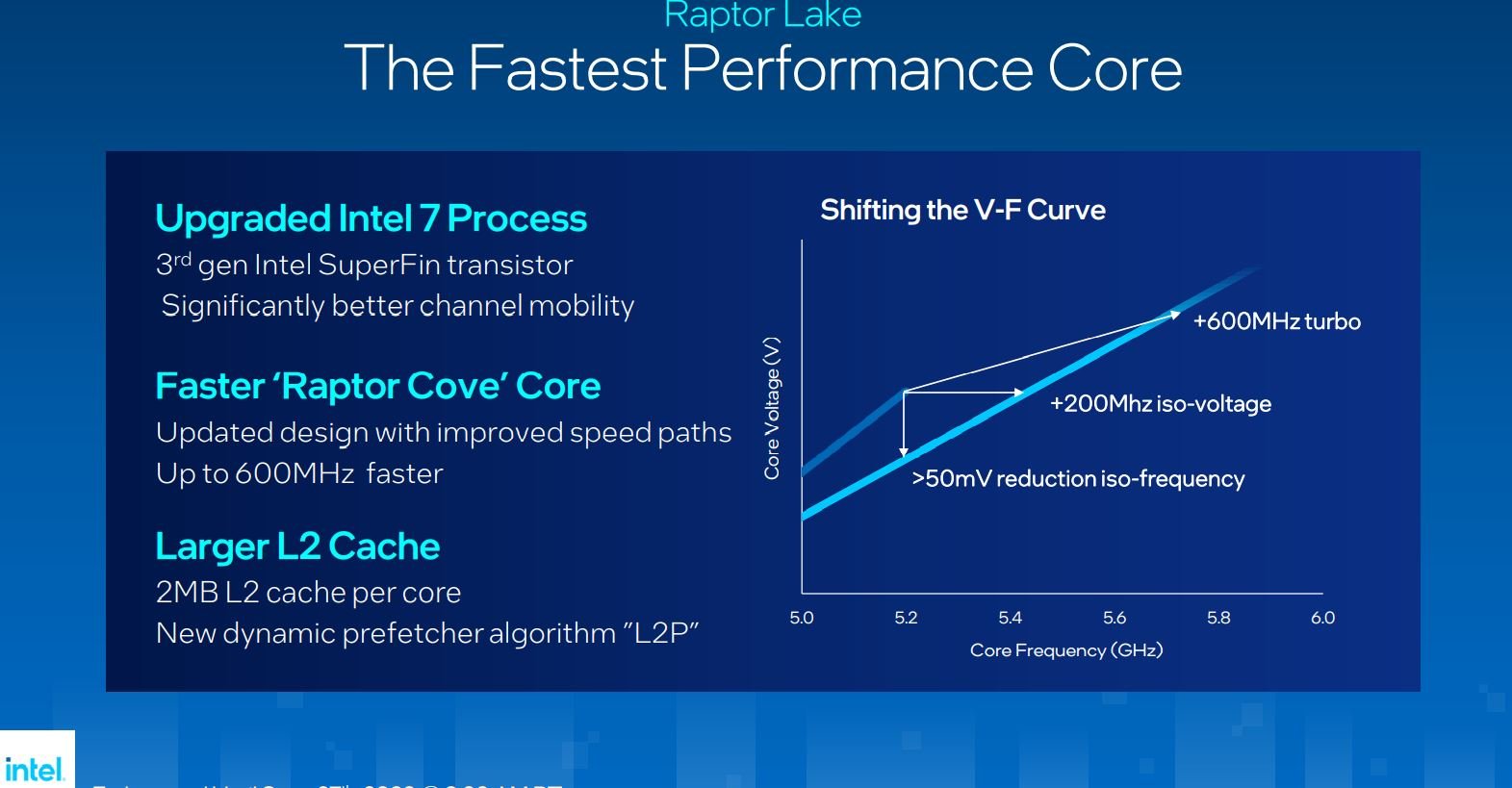
We know E-cores are more numerous this generation and Intel keeps to the tried-and-trusted Gracemont microarchitecture – the smaller cores are identical on Alder and Raptor Lake. That said, performance ought to be better as Intel doubles L2 cache from 2MB per four-core E-core cluster to 4MB. A small but important detail.
P-cores also benefit from more L2 cache. You may recall 12th Gen offered 1.25MB per core – 13th Gen ups this to 2MB. Put simply, an 8P+8E chip (16 cores, 24 threads) from the Alder Lake generation carries a total 14MB L2 (8×1.25 + 2×2) while Raptor Lake jumps to 24MB (8×2 + 2×4). More cache never hurts if latency is kept at around the same levels, and Intel also adds to L3 capacity for each family. Getting the feeling Intel is going Arnie-style gung-ho with nary a thought for ballooning transistor budgets?
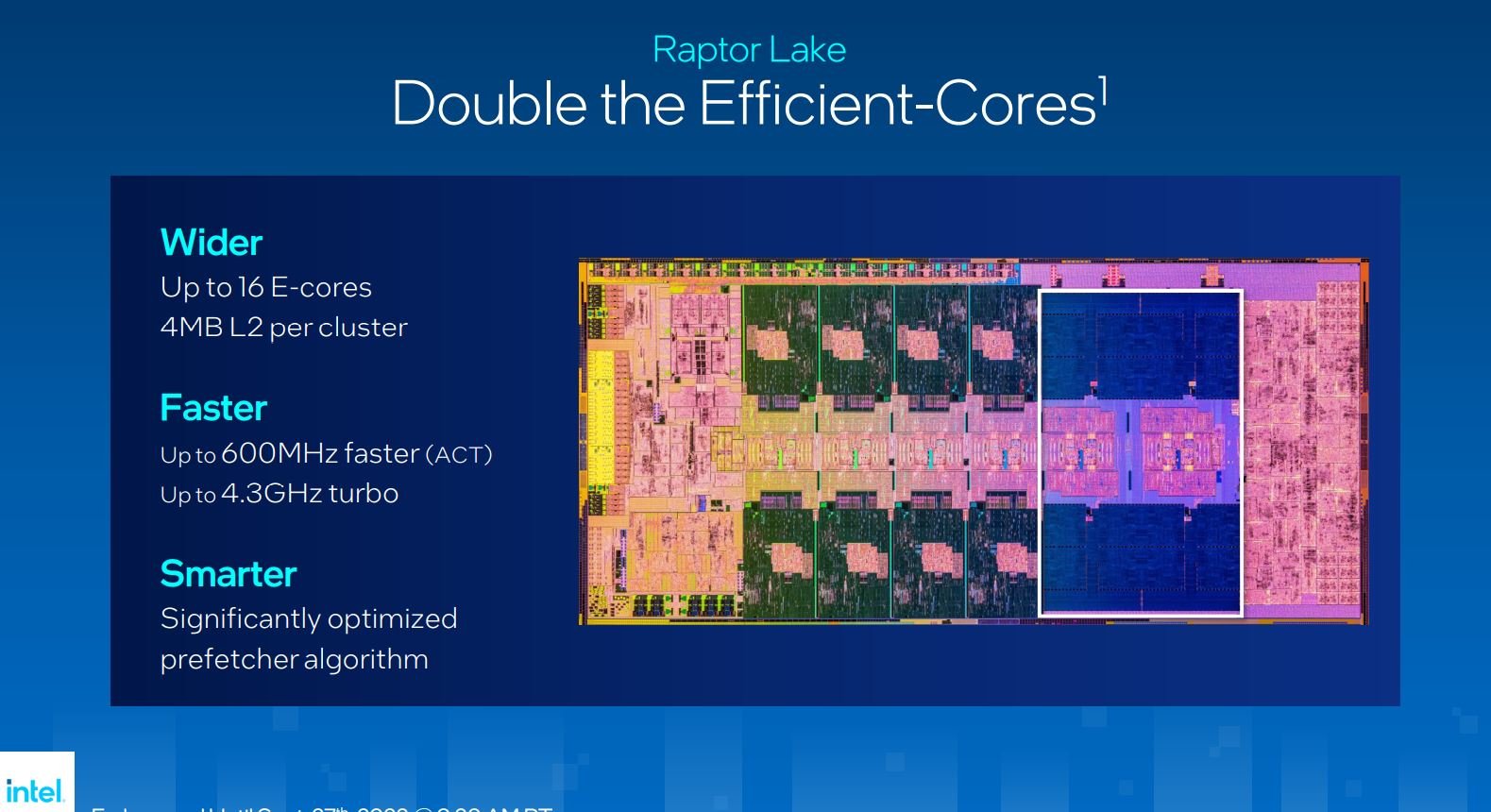
Last of the Monoliths
Intel’s forward-looking architecture strategy is to shift away from a monolithic die – where all constituent IPs are integrated into one piece of silicon – and favour disaggregated design instead. Rendering 13th Gen Core last of the client-side monoliths, Raptor Lake has the honour of being the last of a long time of high-performance desktop processors built in a particular fashion. Le Roi est mort, vive le Roi.
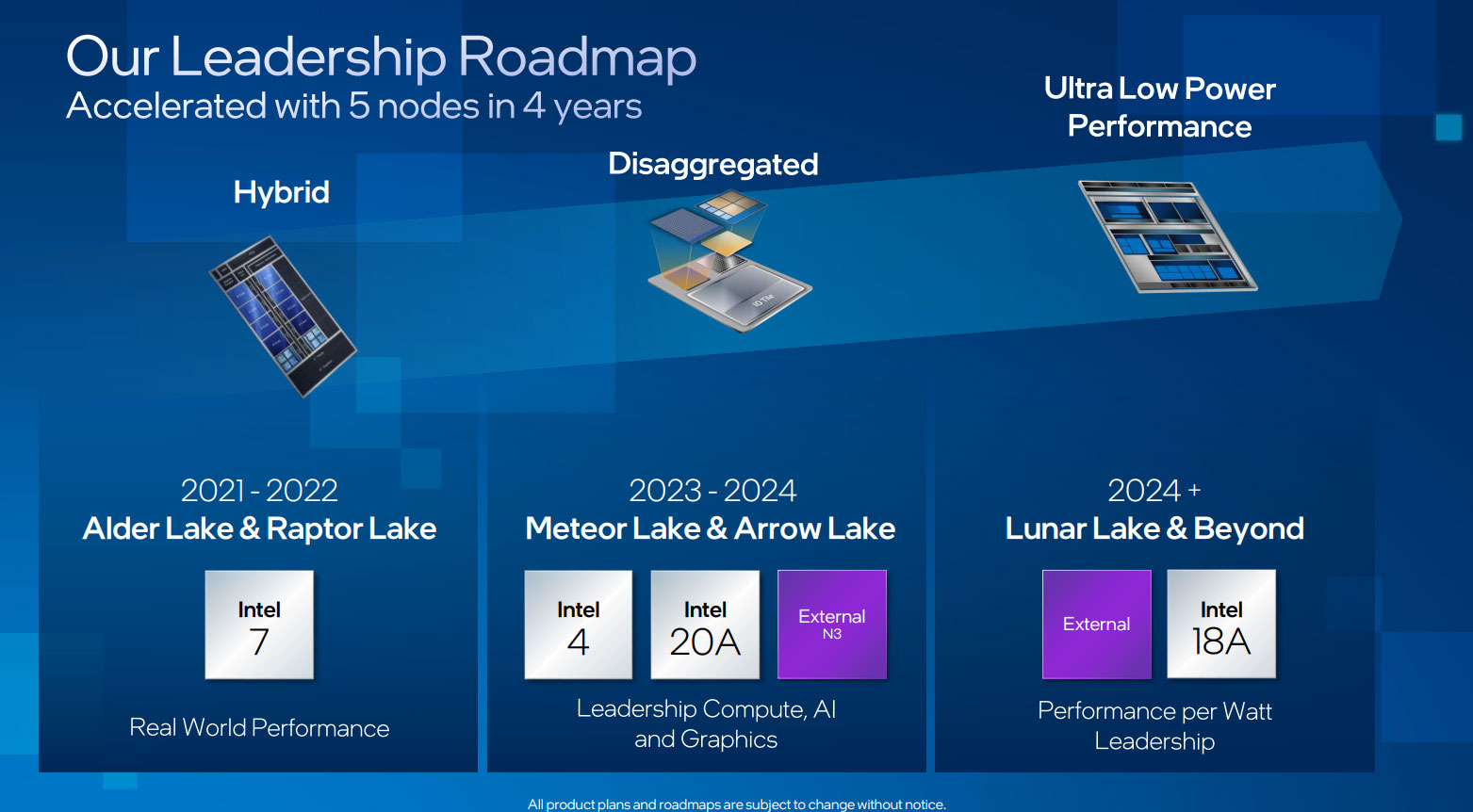
Raptor Cove Operates Differently To Golden Cove
But pull the curtain back and a few new additions come into view. Raptor Lake uses a significantly optimised prefetching algorithm. Speaking to Adi Yoaz, chief architect for P-cores, this is actually a feature baked into Alder Lake too. There’s a firmware-upgradeable power management microcontroller built into Alder Lake’s Golden Cove P-cores which runs on a per-core basis and offers fine-grained adjustments.
Intel’s fastest-ever client processor is armed and ready to wreak havoc.
For Raptor Cove P-cores, however, Intel is extending the reach of this microcontroller to adjust other aspects of the core aside from monitoring telemetry and frequencies. In hushed tones, Yoaz informed Club386 Intel can control the behaviour of the prefetching unit and whether L2 and L3 caches are inclusive or non-inclusive by introducing new algorithms through firmware updates. Knowing the microcontroller affects parameters every 200 microseconds, there’s plenty of on-the-fly optimisation taking place on Raptor Cove. What’s more, constant machine learnings update algorithms such that application performance improves over time.
In the future, using this microcontroller, “Intel will have more and more algorithms that will adapt and modify the machine to the actual application that’s being run,” continued Yoaz.
Given this is a firmware-led upgrade and the microcontroller technology already exists in Alder Lake, an interesting question is whether it can be backported to 12th Gen Core for improved performance. Intel chose not to answer this pressing question during our chat with Adi at a technical tour event in Israel a few weeks back. The enhanced prefetching and cache algorithms in Raptor Cove are marketing decisions first and foremost, to help differentiate from the direct predecessor which effectively uses the same core technology. Liberally applied in the server business, Intel is no stranger to expanded performance via firmware updates.
Rumours are abounding that processors below the Core i5-13600K(F) will use Alder Lake technology rather than Raptor Lake, with core-and-thread counts and frequency massaged to fit into the intended Core i5 and Core i3 segments. Time will tell.
Models And Comparisons
| CPU | Cores | Threads | L2 | L3 | Turbo | Base TDP | Max TDP | MSRP |
|---|---|---|---|---|---|---|---|---|
| Core i9-13900K | 24 (8P+16E) | 32 | 32MB | 36MB | 5.8GHz | 125W | 253W | $589 |
| Core i9-12900K | 16 (8P+8E) | 24 | 14MB | 30MB | 5.2GHz | 125W | 241W | $589 |
| Core i7-13700K | 16 (8P+8E) | 24 | 24MB | 30MB | 5.4GHz | 125W | 253W | $409 |
| Core i7-12700K | 12 (8P+4E) | 24 | 12MB | 25MB | 4.9GHz | 125W | 190W | $409 |
| Core i5-13600K | 14 (6P+8E) | 20 | 20MB | 24MB | 5.1GHz | 125W | 181W | $319 |
| Core i5-12600K | 10 (6P+4E) | 16 | 9.5MB | 20MB | 4.9GHz | 125W | 150W | $289 |
Getting swiftly back on track, presented here are some of the best CPUs from the 12th and 13th Gen families. Key to Core i5-13600K’s success are three factors: more cores, more frequency, and more on-chip smarts.
Top-bin Core i5 continues to evolve over time. Think back to Rocket Lake-based, symmetrical Core i5-11600K. Not a bad chip, most would say, yet the six-core, 12-thread design pales into mediocrity against today’s i5-13600K. In fact, don’t think of this as an i5 at all; with respect to performance, it has far more in common with i7 of the 12th Generation.
Six P-cores scale up to 5.1GHz whilst the remaining E-cores wrestle their way to 3.9GHz. Understanding 13th Gen Core is a larger, more powerful CPU than its predecessor forces Intel to drive harder to achieve stated frequencies. Readily apparent by the increase in maximum TDP from Core i5-12600K’s 150W to 181W here, similarities to last-gen i7 continue, where, for example, 12700K is given 190W to play with.
| Core i5-13600K | AMD Ryzen 5 7600X | AMD Ryzen 7 7700X | |
| Cores/threads | 14/20 | 6/12 | 8/16 |
| Peak frequency | 5.1GHz | 5.3GHz | 5.4GHz |
| L2+L3 cache | 44MB | 38MB | 40MB |
| Max TDP/PPT | 181W | 142W | 142W |
| Recommended price | $319 | $299 | $399 |
Make no mistake, Core i5-13600K is a powerhouse of a mid-range CPU. Priced at $319 and compared to its nearest AMD Ryzen 7000 Series rivals, enhanced core-and-thread counts stand out most. Of course, the comparison isn’t that simple because AMD uses symmetrical cores whilst Intel ploughs on with a hybrid approach… but you get the picture – Team Blue has seriously upped the game across desktop Core families. Ryzen 5 7600X’s 6C12T design is vastly undergunned against what Intel offers at a similar price point.
Intel has deliberately overdelivered specifications for 13th Gen Core, and the strategy is one of using the well-proven, comparatively inexpensive 10nm process on a value-focussed chip – offering a 20-thread CPU at $319 is unheard of – which puts rival AMD into an ever-tightening financial spot. What better way to blunt your only competitor’s all-new platform launch than by going super-aggressive on performance and price.
An i7 In All But Name
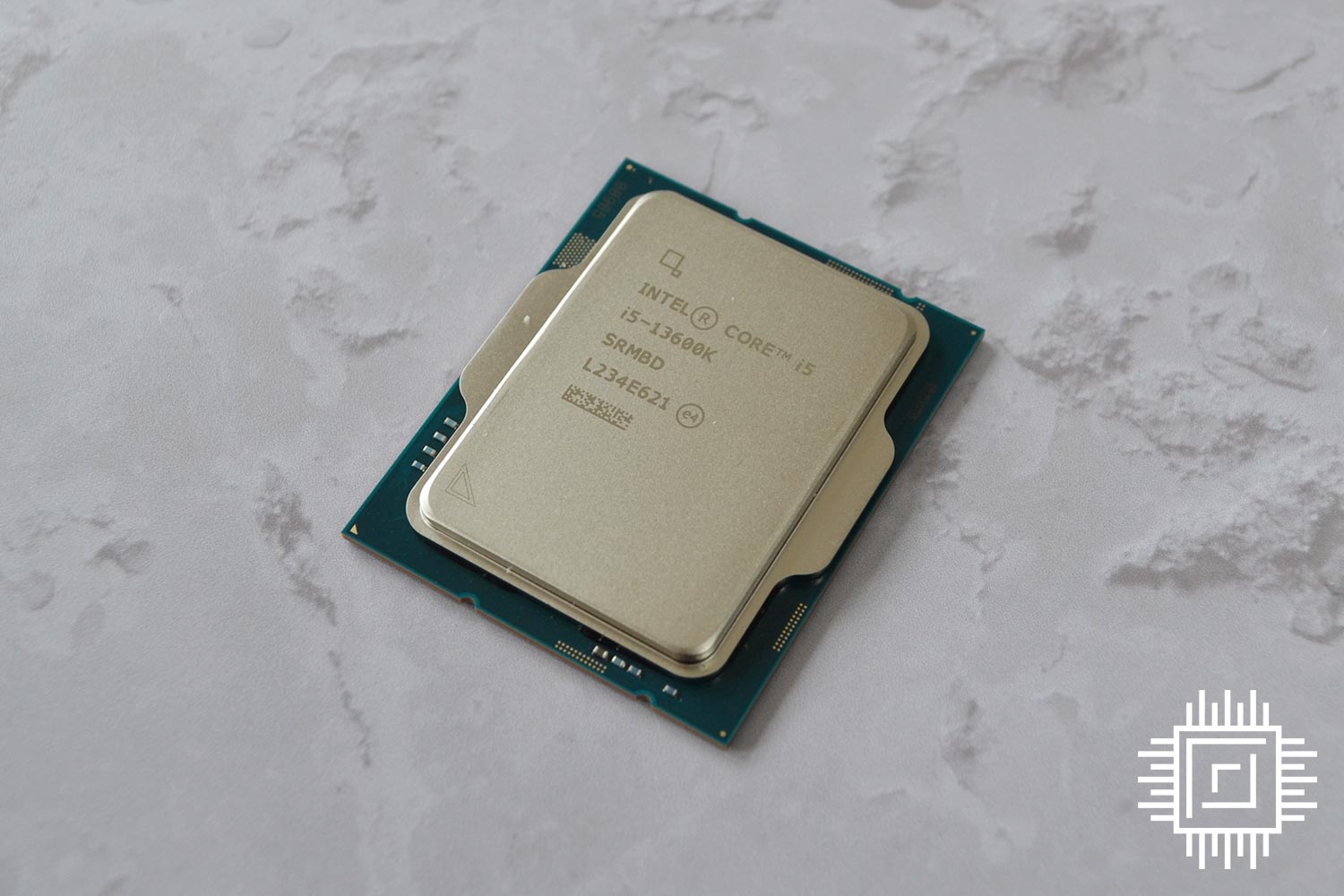
Powerful as it may be, Core i5-13600K is staid in appearance. The LGA1700 processor fits into Intel 600 and 700 Series chipsets and, thanks to a hybrid memory controller, works with either DDR4 or DDR5 memory. That’s a key selling point, actually, as we imagine many users opting for a $300 CPU want to keep overall system costs in check. A perfectly serviceable B660 board costs $150 and 32GB of DDR4-3600 is available for sub-$100. Considered as an entire platform, overall outlay is less than competing Ryzen 7000 Series/AM5.
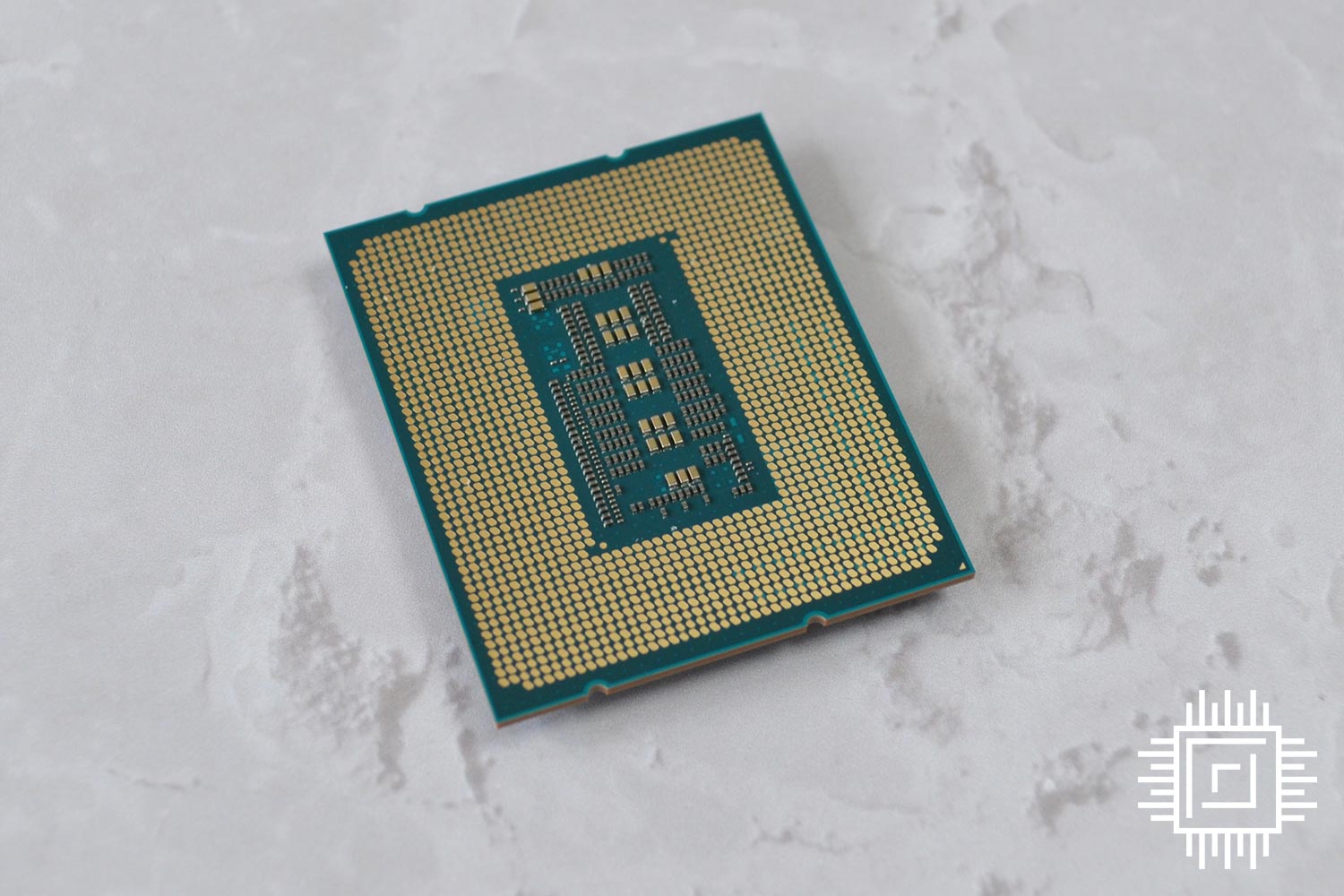
Nevertheless, both Intel and AMD have shied away from including coolers in retail boxes. Any decent air cooler will do for stock settings, but do budget an extra $40 on top.
Gamers not requiring the basic, baked-in UHD 770 graphics can opt for the otherwise identical Core i5-13600KF. Doing so drops retail price from $319 to $294, making it even more of a bargain if there’s a discrete graphics card at the ready.
Performance
Tests are carried out on Core i5-13600K on top of an Asus Maximus ROG Z790 Hero motherboard, 32GB (2x16GB) of G.Skill Trident Z5 Neo EXPO CL30 memory operating at official specifications of DDR5-5600 (CL30). The supporting cast, also common between all processors, consists of an Nvidia GeForce RTX 3080 FE graphics card, Seagate FireCuda 530 2TB SSD, and Noctua NH-D15 cooling. The ensemble is powered by a be quiet! Dark Power 13 1,000W PSU. The review chip is run at Intel-mandated settings of 181W maximum power.
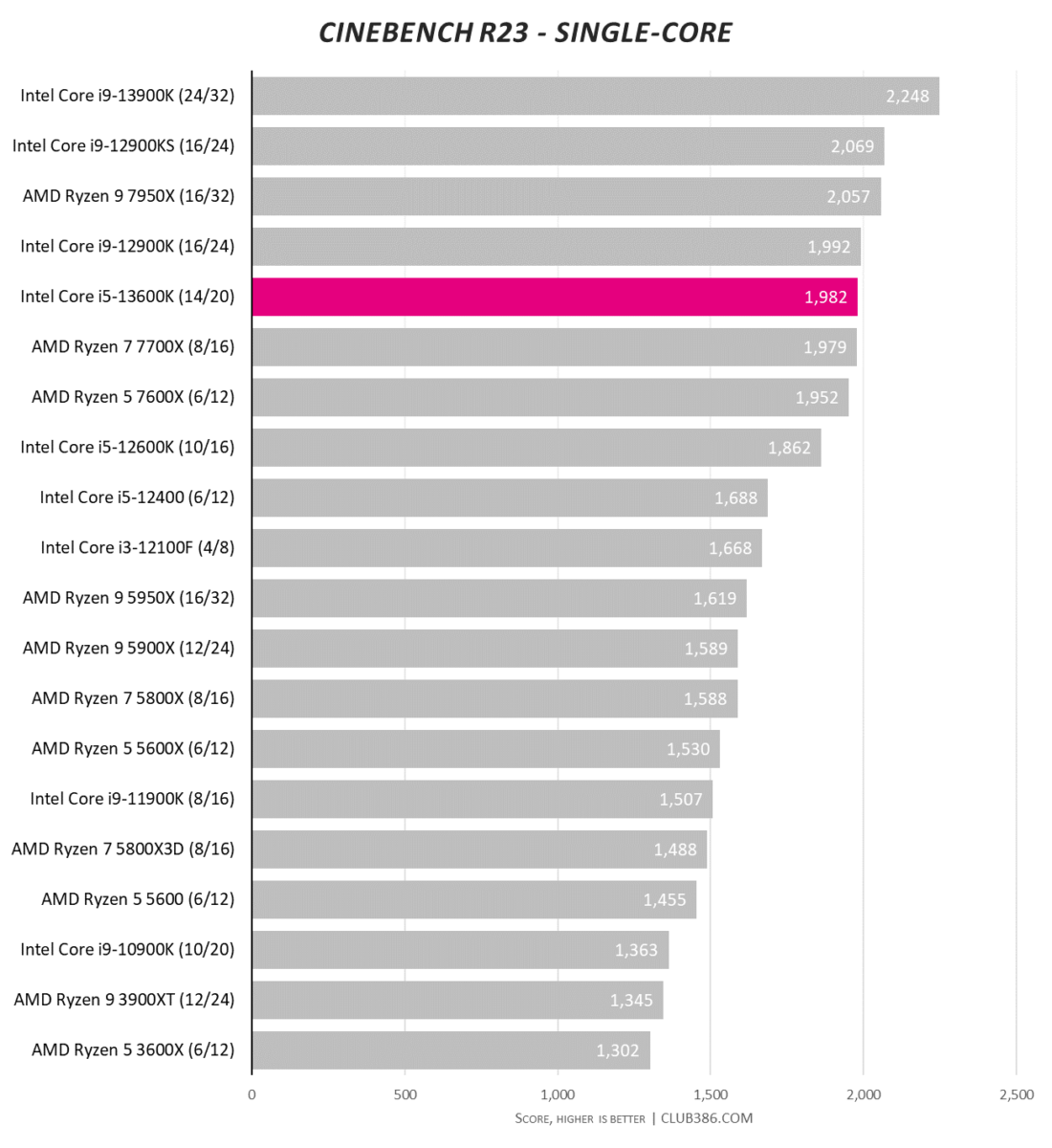
Off to a great start, Core i5 effectively matches the best Core i9 from the last generation in light-load tests. Bodes well, doesn’t it?
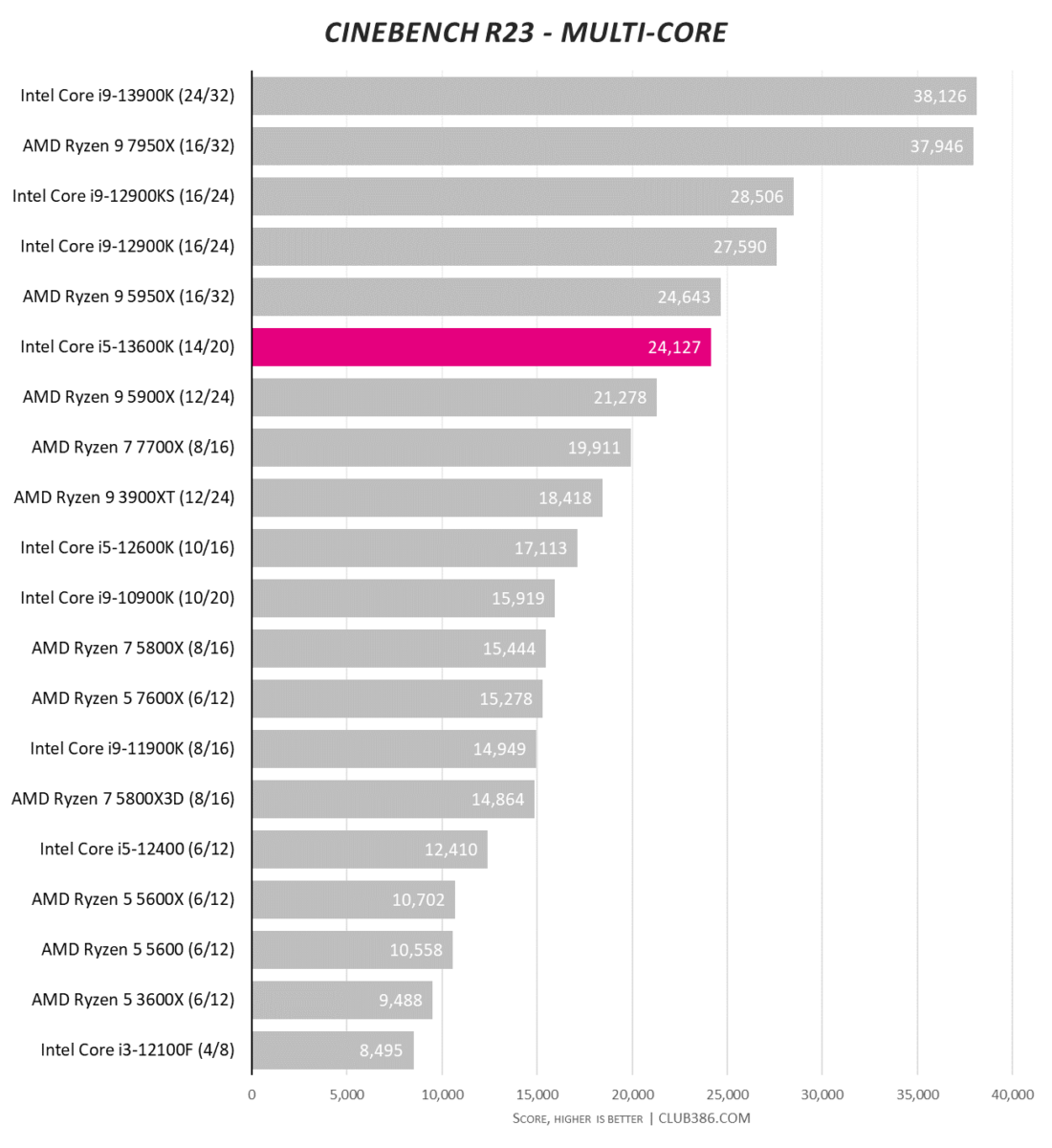
Drum roll, please. The 13th Gen Core i5 champ is rather adept at multi-core workloads. Over 40 per cent faster than the Core i5-12600K is impressive enough in its own right, but the real smackdown happens to Ryzen old and new.
Core i5-13600K is fundamentally quicker than a Ryzen 7 7700X, which, let’s not forget, arrives at retail armed with a $399 ticket price. This is looking rather good for Intel. Further administering a swift kick to the Ryzen 5 7600X goolies, it’s not even a contest.
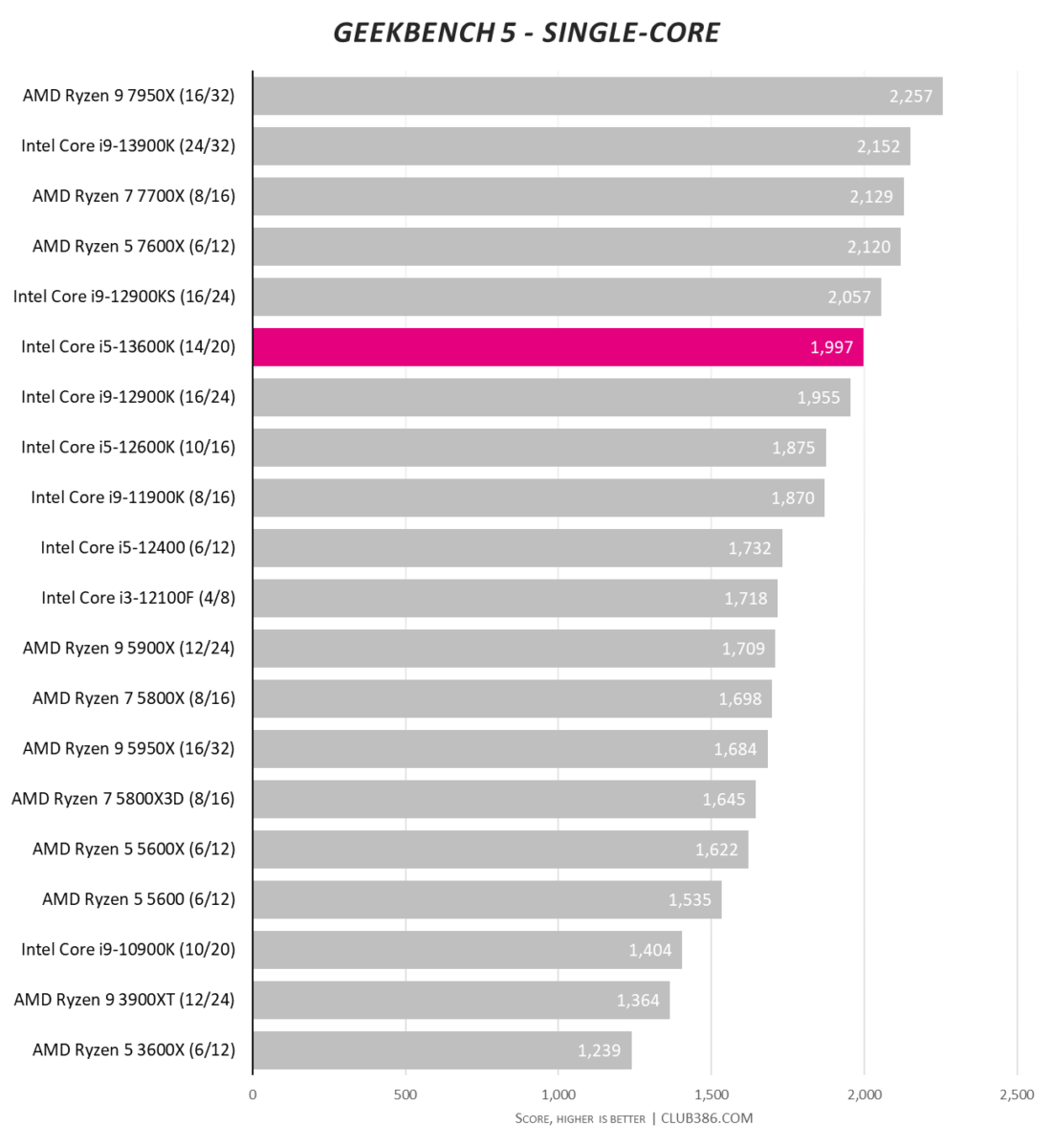
Reinforcing the first result, extra caches and higher memory bandwidth for 13th Gen Core bring our test chip up to the same levels exhibited by the best of Alder Lake.
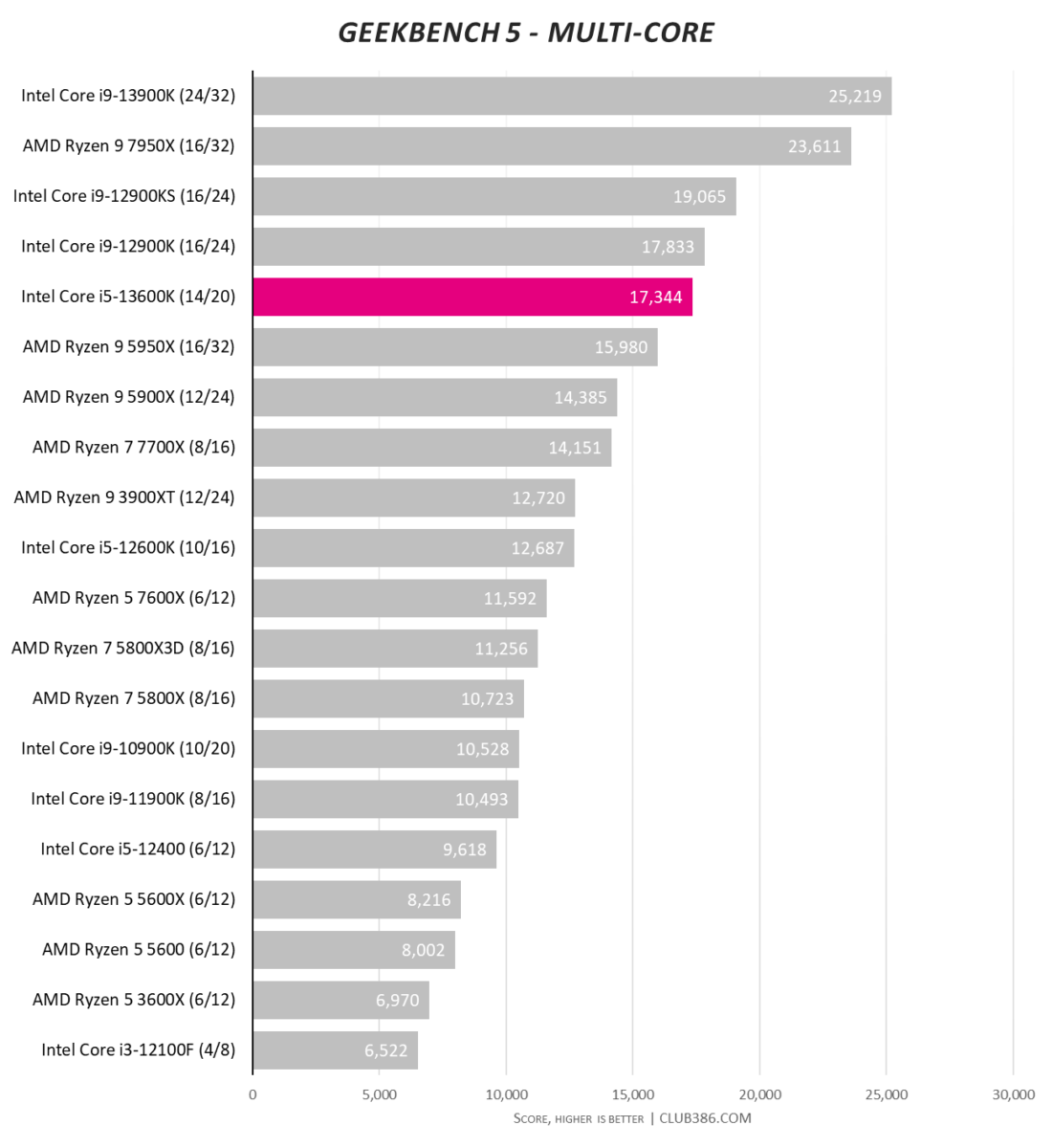
Benchmarks be damned, Core i5-13600K is within a stone’s throw of Core i9-12900K. What more do we need to say?
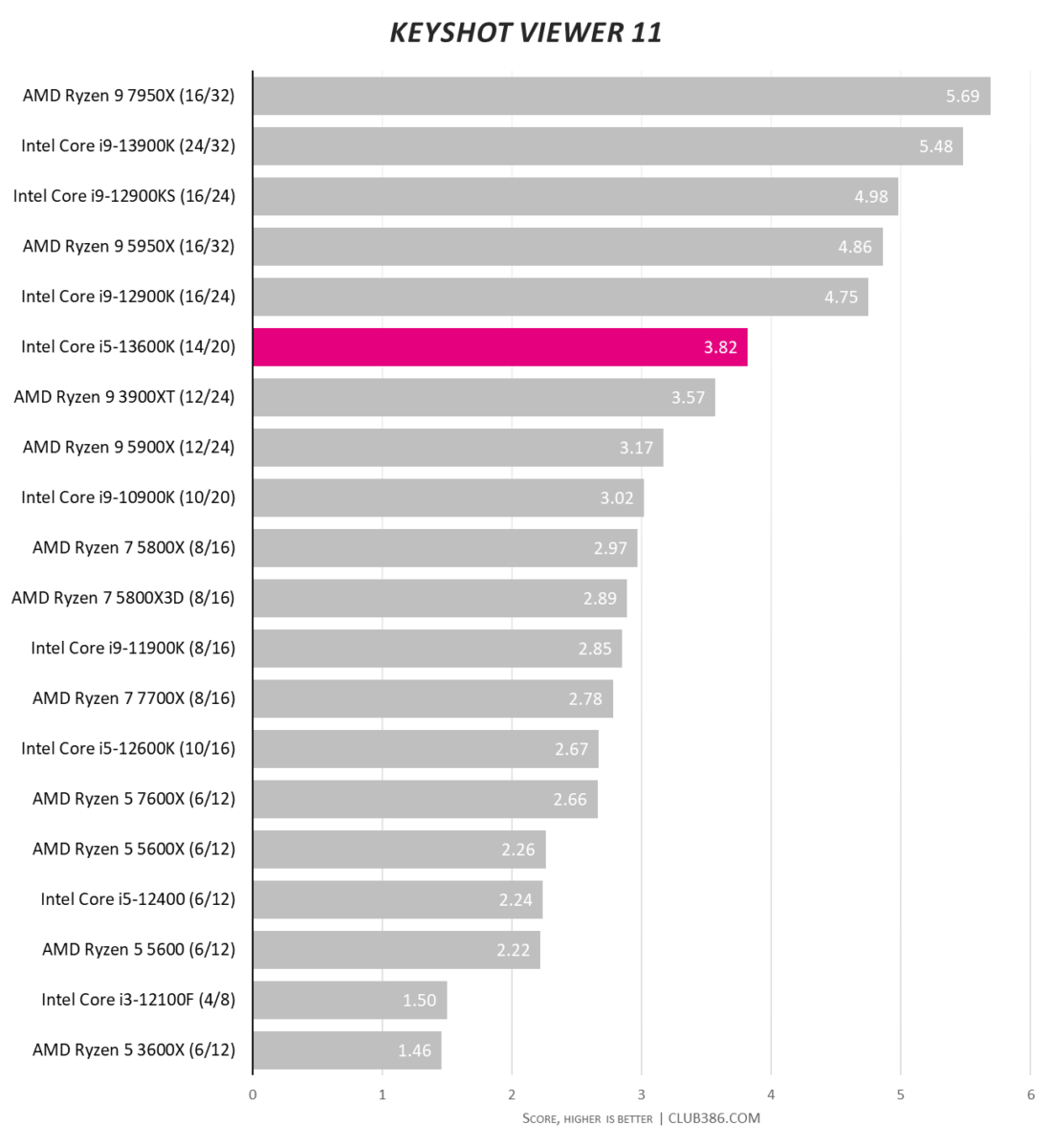
Having fewer P-cores than 12th Gen champions stops our comparison from continuing. But hey, Core i5-13600K still puts up a robust showing.
| Core i5-13600K | AMD Ryzen 5 7600X | AMD Ryzen 7 7700X | |
|---|---|---|---|
| 7-zip 19.00 (HIB) | 124,149 MIPS | 96,624 MIPS | 119,843 MIPS |
| Blender 3.3.0 (HIB) | 352.9 samples | 239.2 samples | 311.4 samples |
| V-Ray 5.0.20 (HIB) | 16,444 samples | 11,600 samples | 15,100 samples |
| y-cruncher 9513 (LIB) | 170.5 seconds | 192.5 seconds | 167.8 seconds |
Knowing many readers look toward these mainstream processors as everyday workhorses, we’ve benchmarked additional multi-core applications with the three main $299-$399 protagonists. The most relevant comparison for the $319 Core i5-13600K is the $299 AMD Ryzen 5 7600X.
Intel continues to hold performance sway against both Ryzens.
Memory
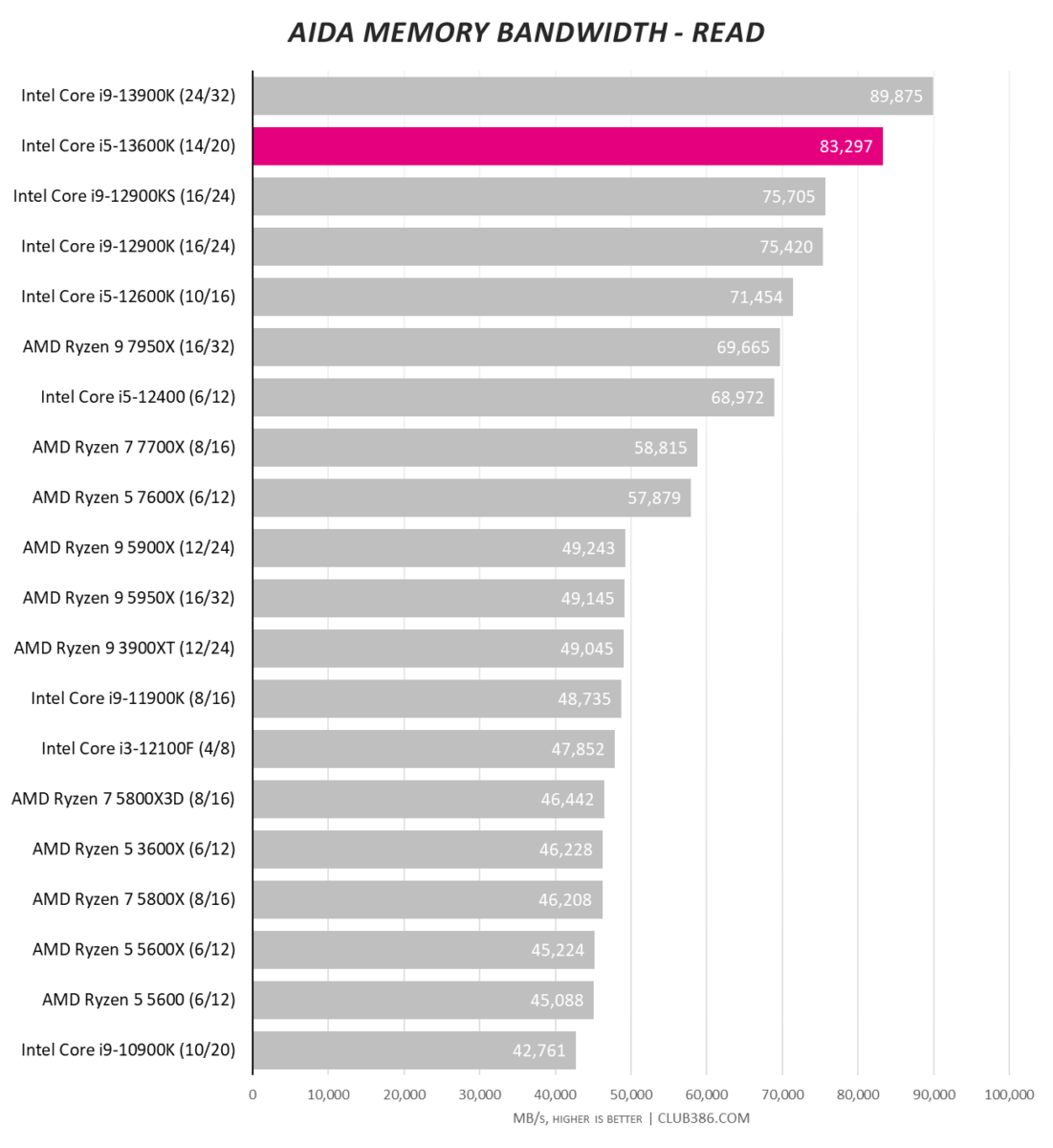
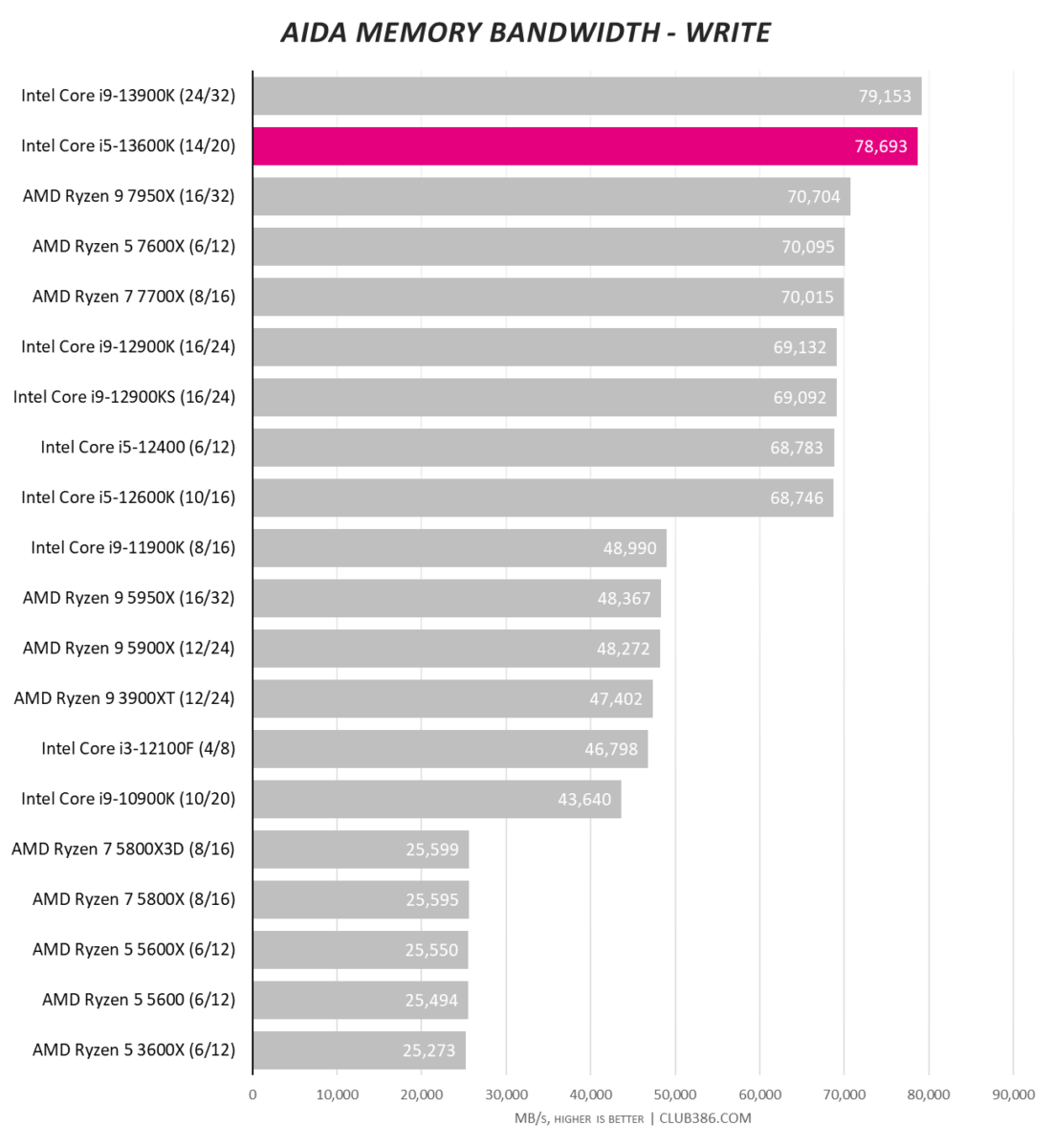
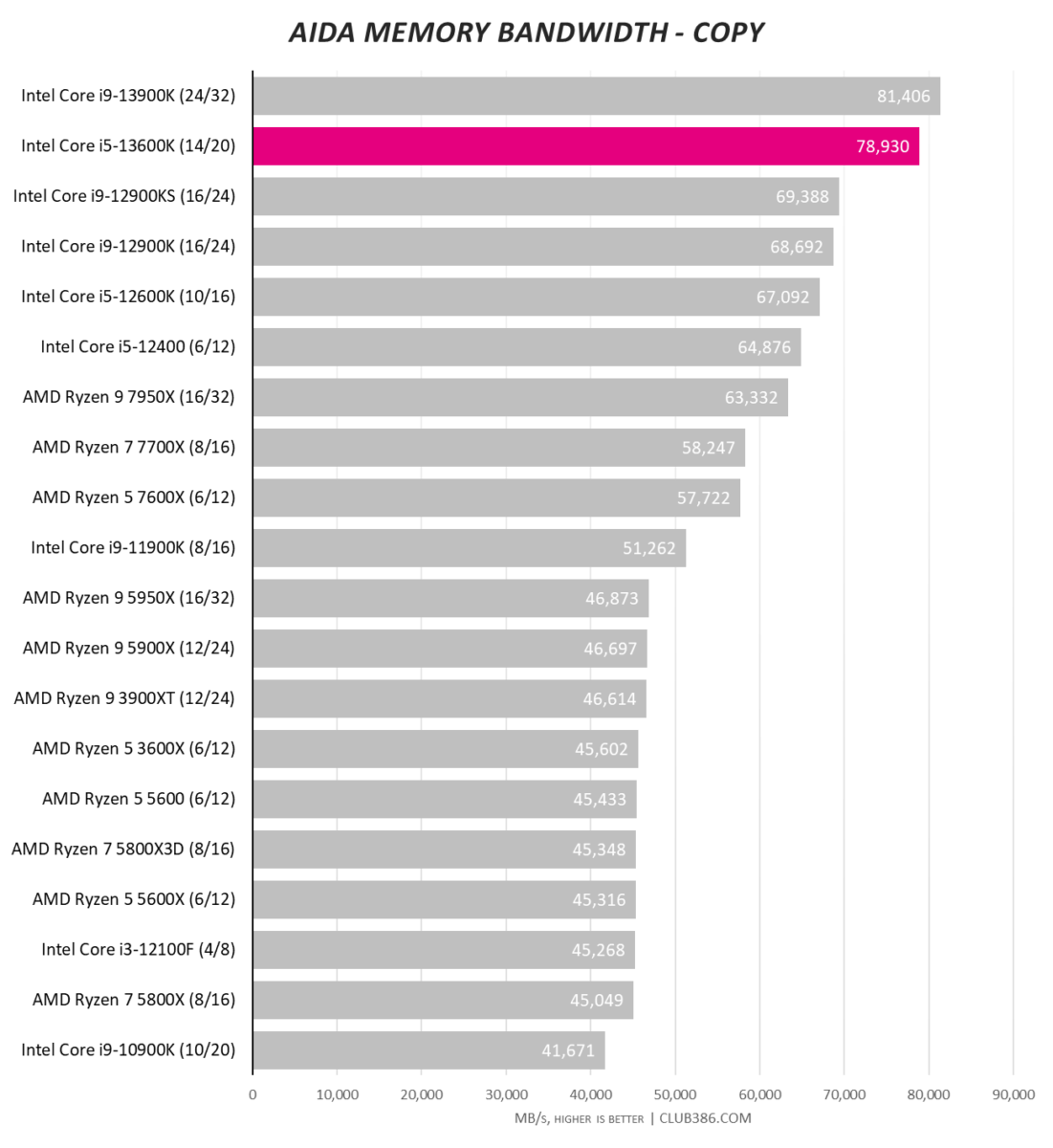
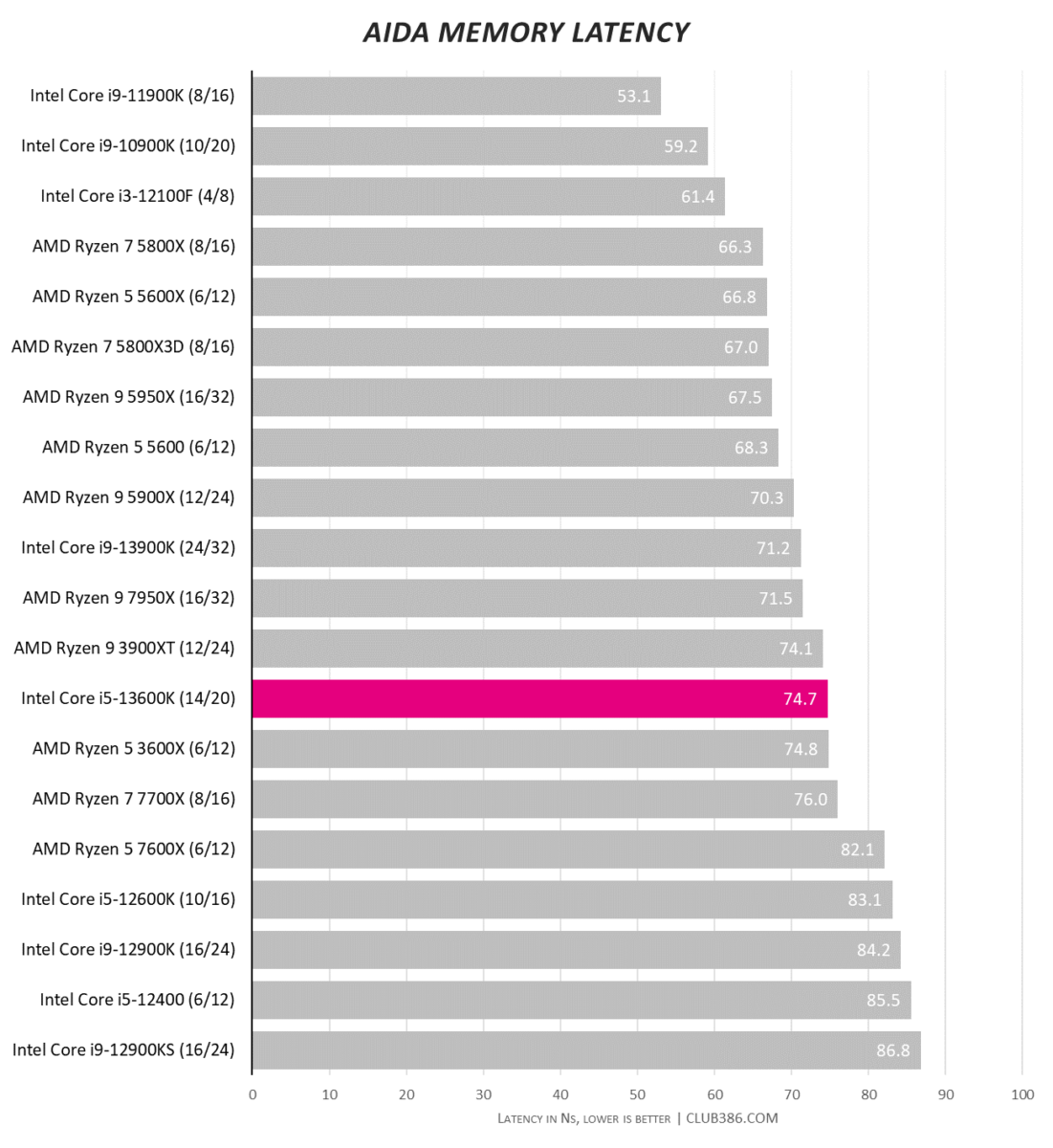
Running memory at the same speed and latency as the Core i9-13900K has obvious benefits in these synthetic tests. Performance isn’t quite as sharp, mainly due to a lower peak speed, yet it’s hard to criticise.
System and Gaming
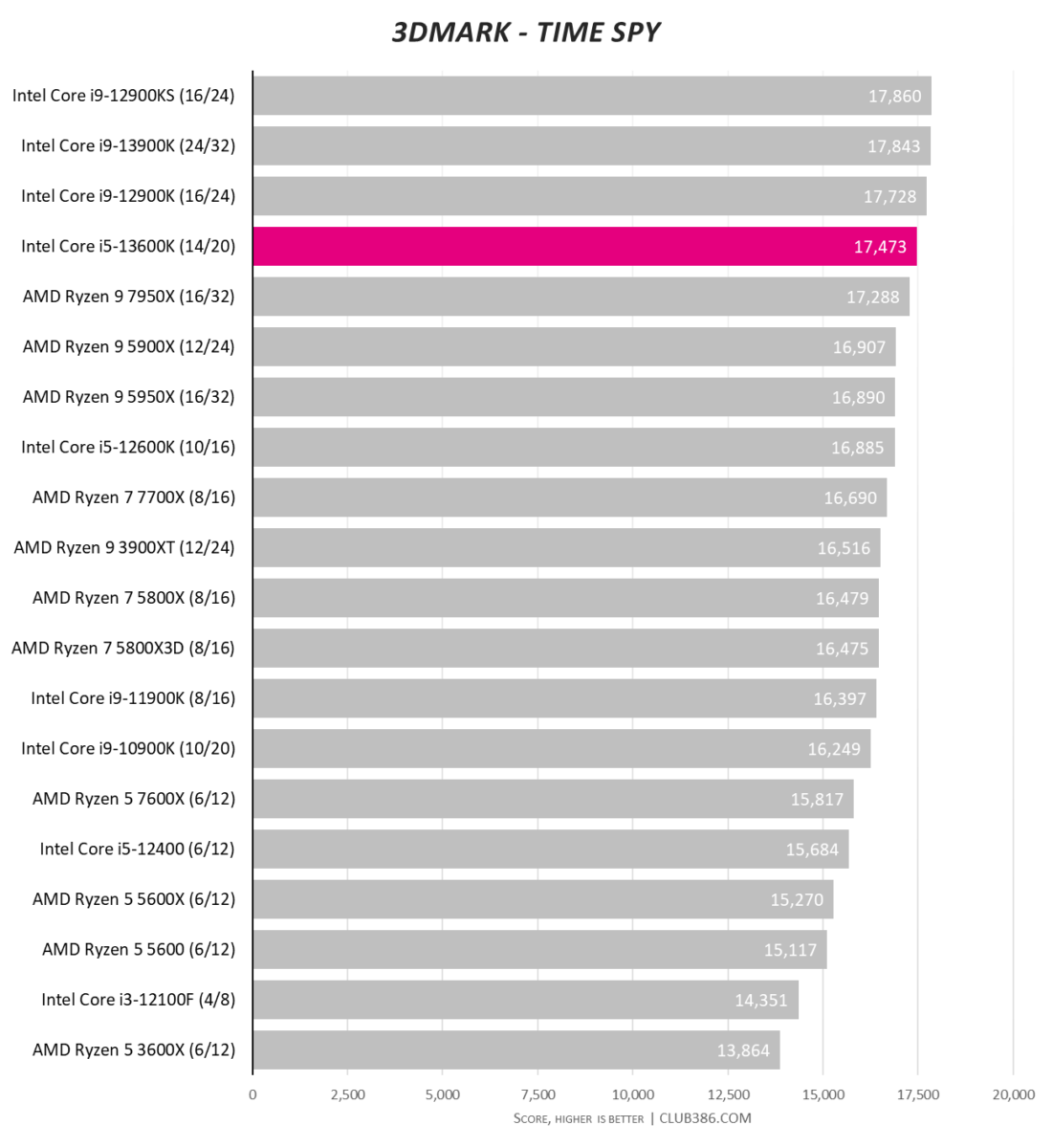
Understanding that single-core performance is electric means the 3DMark Time Spy result comes as no surprise. Little ol’ Core i5 beats huffing and puffing Ryzen 9.
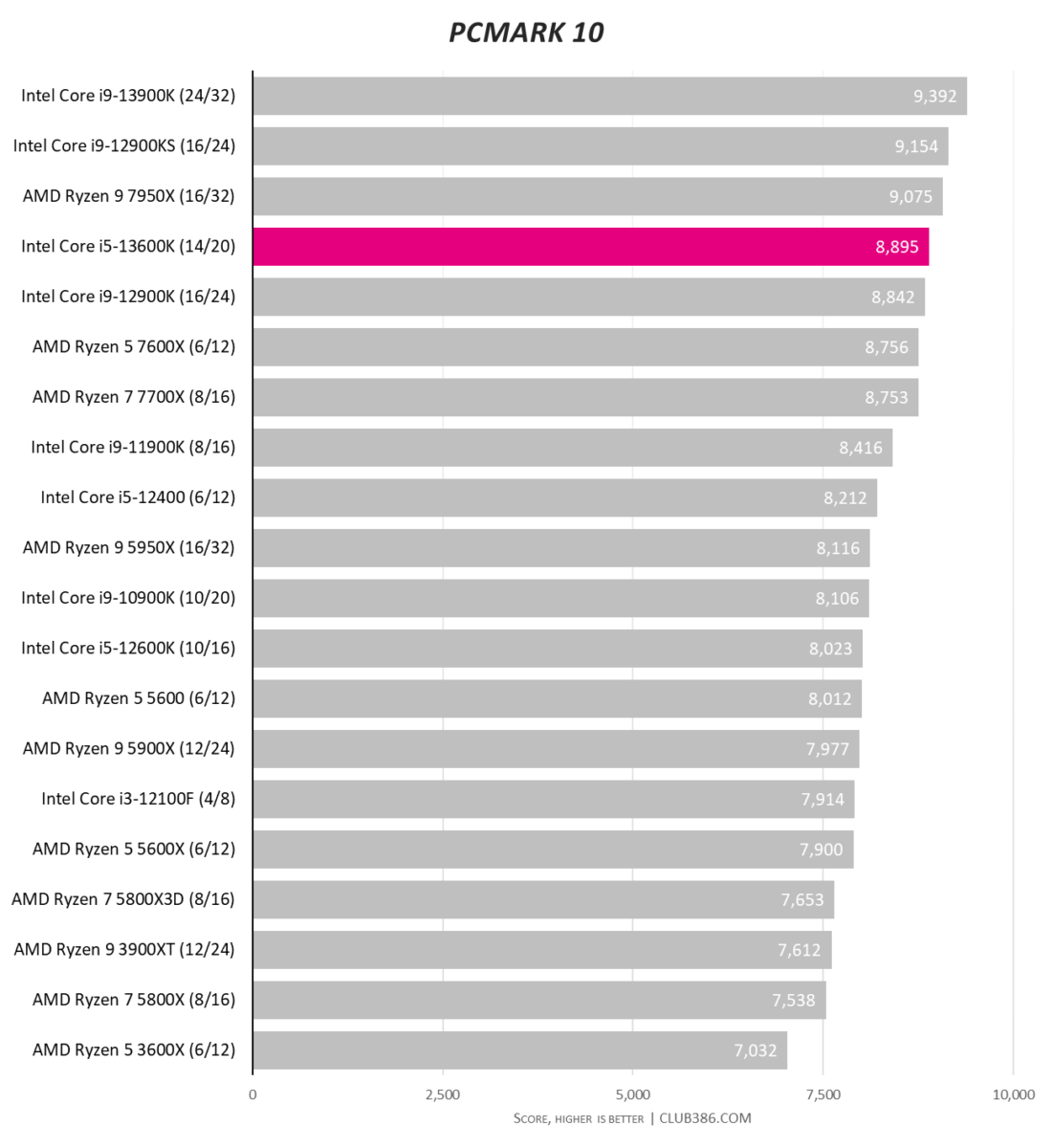
Core i5 is no longer the country bumpkin of the overall range; this is a chip to be taken seriously.
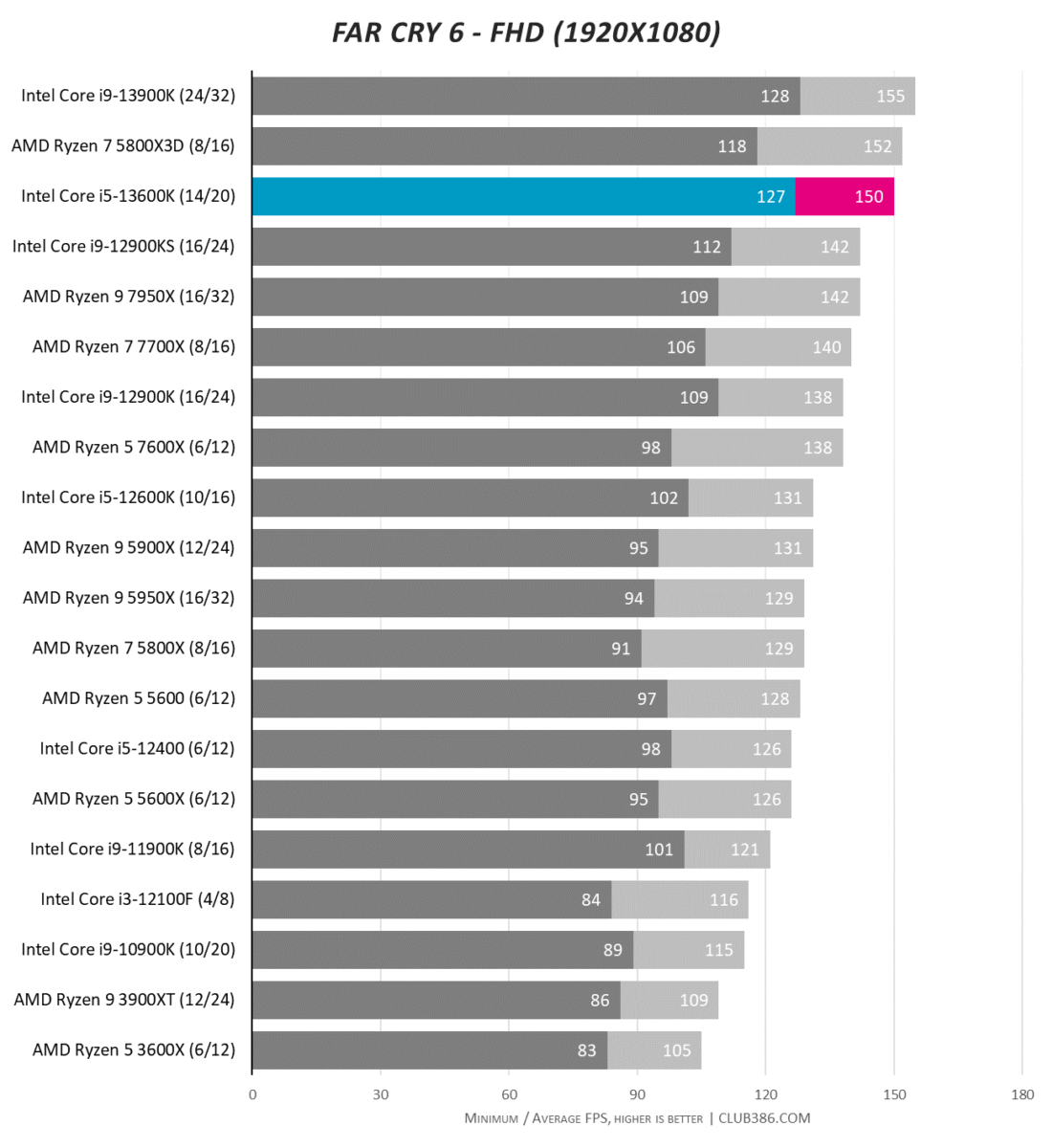
Well, this is interesting. Core i5-13600K beats every Intel 12th Gen Core and Ryzen 7000 Series processor. If you thought this little champ was good in general applications, it’s started off even better in gaming.
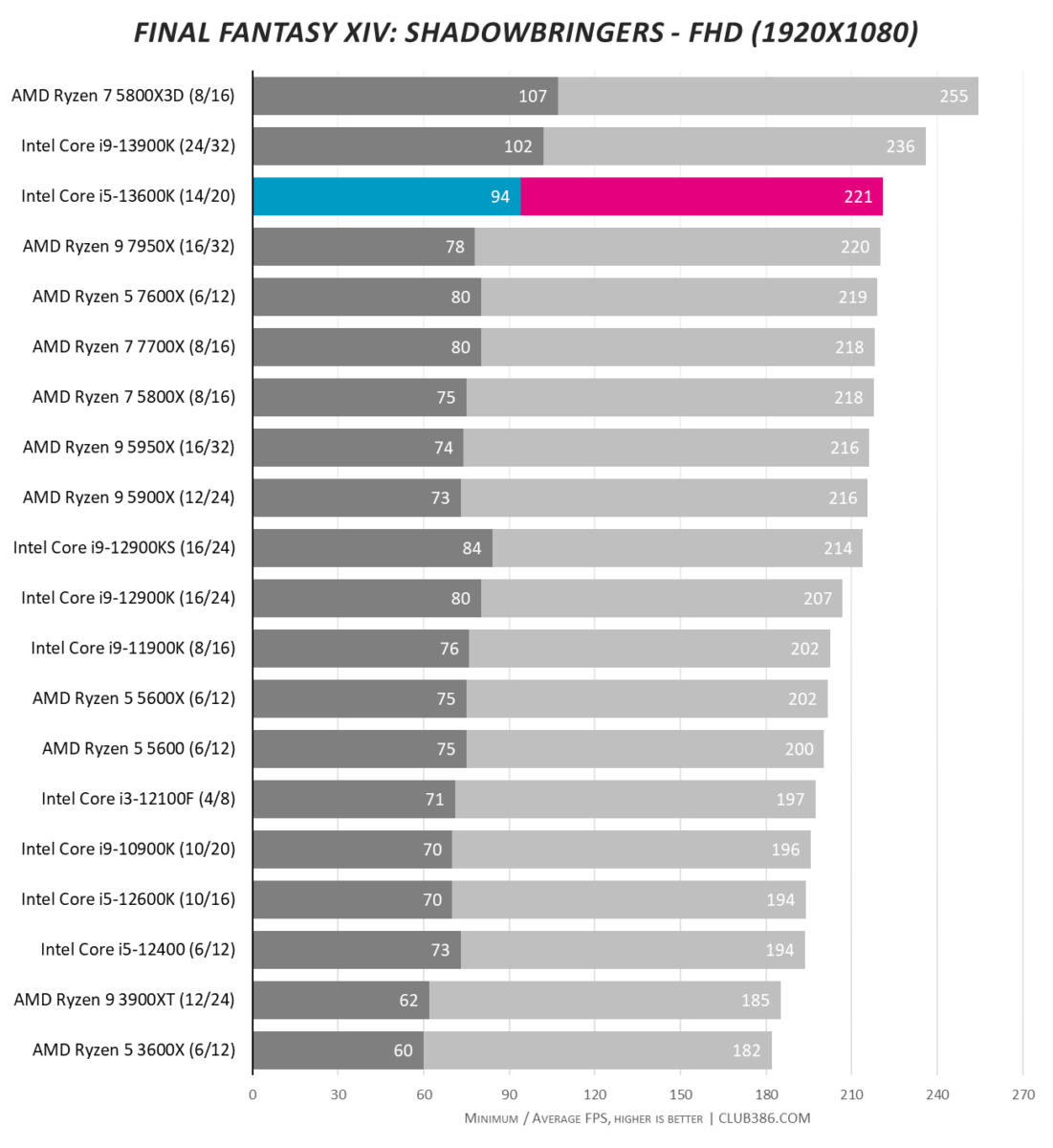
Only the mighty Core i9-13900K and cache-enriched Ryzen 7 5800X3D topple the review chip’s FHD performance.
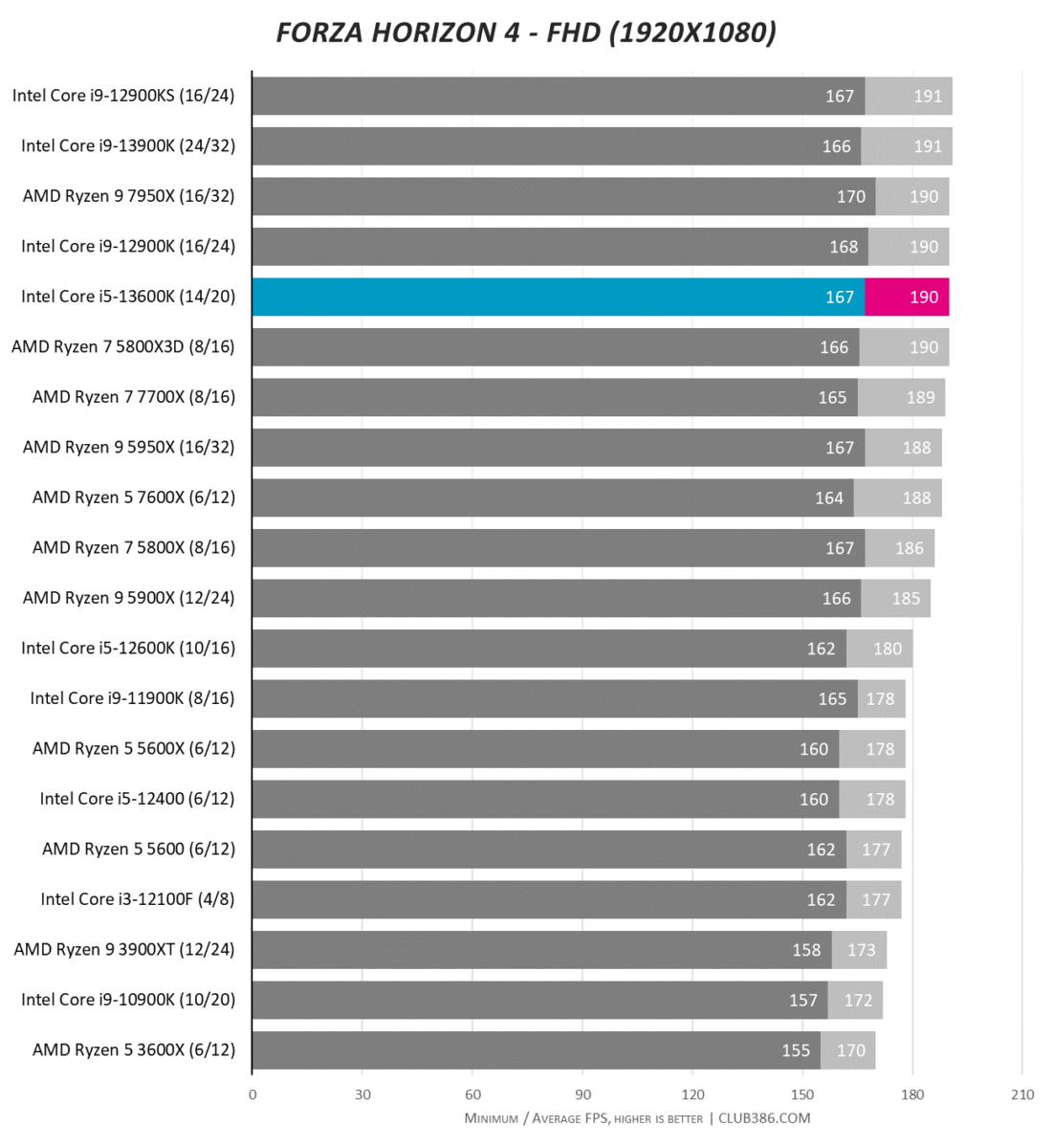
Another game, another excellent result.
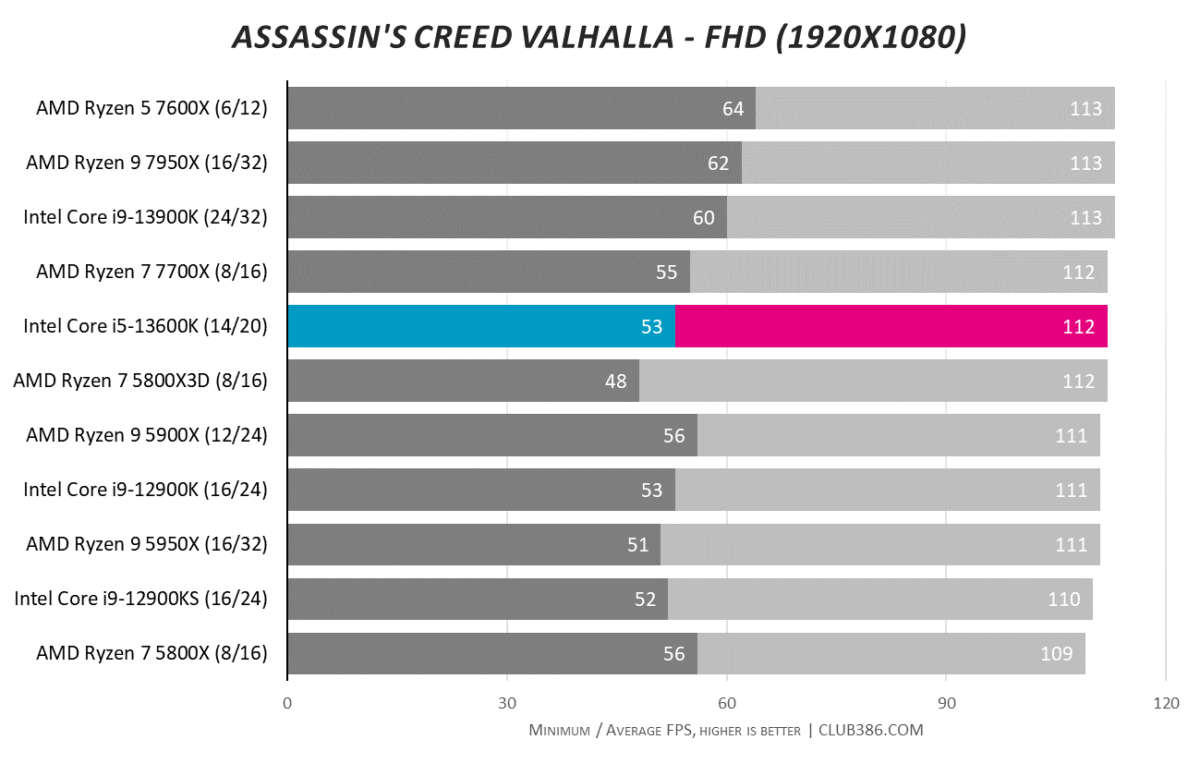
Assassin’s Creed Valhalla is a GPU-bound affair not favouring any recent processor over another.
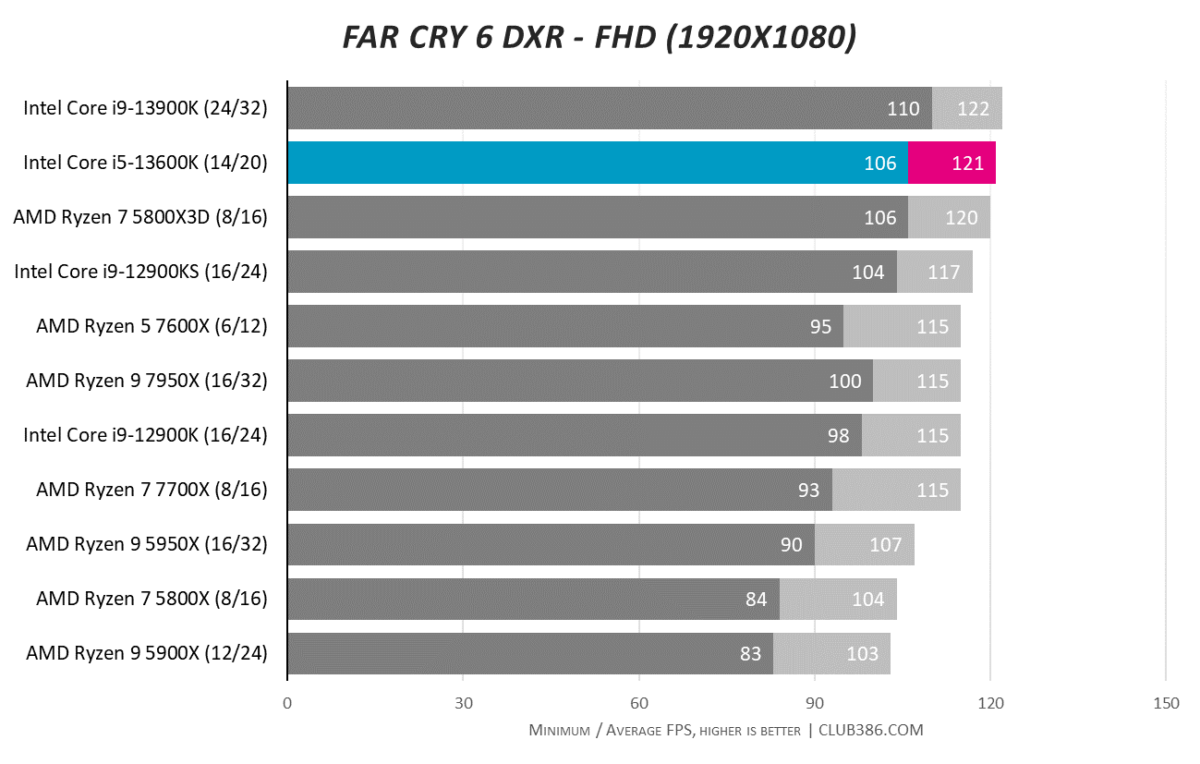
Run with ray tracing on this time around, Core i5-13600K continues to beat up on all 12th Gen Core and Ryzen 7000 Series CPUs. The results are scarcely believable for a chip with such a lowly model designation.
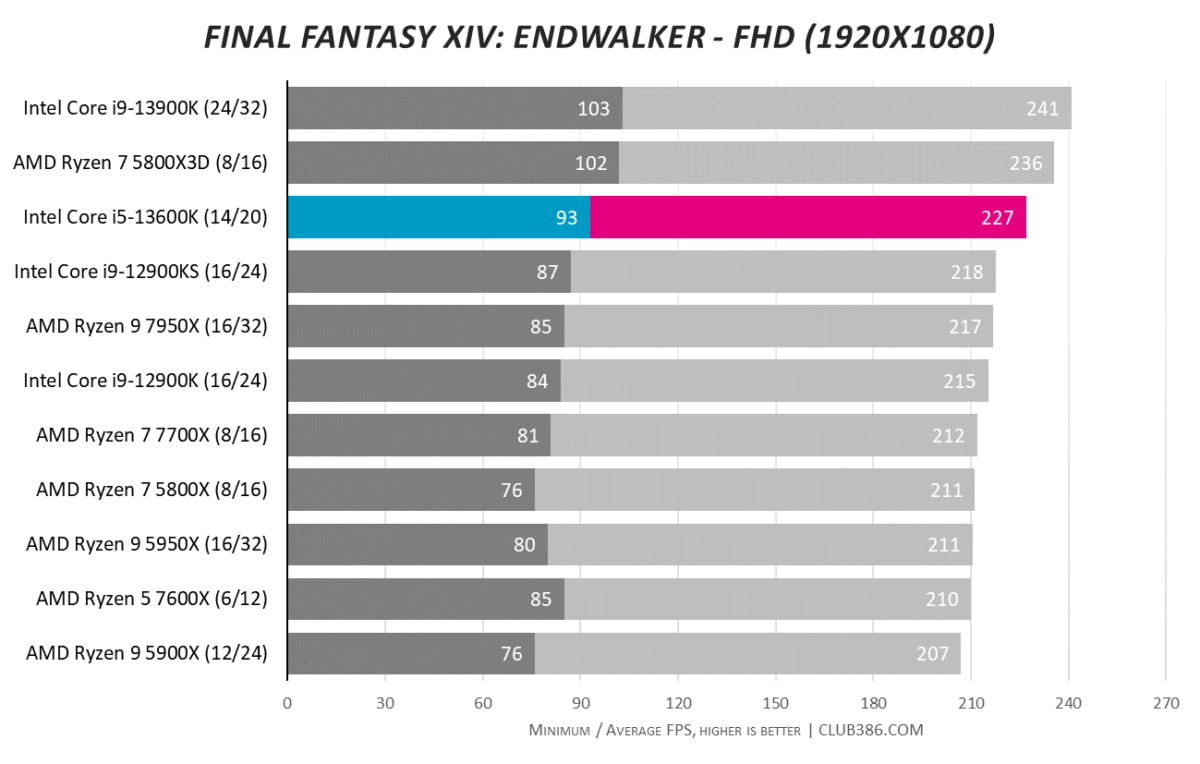
Did you expect any different?
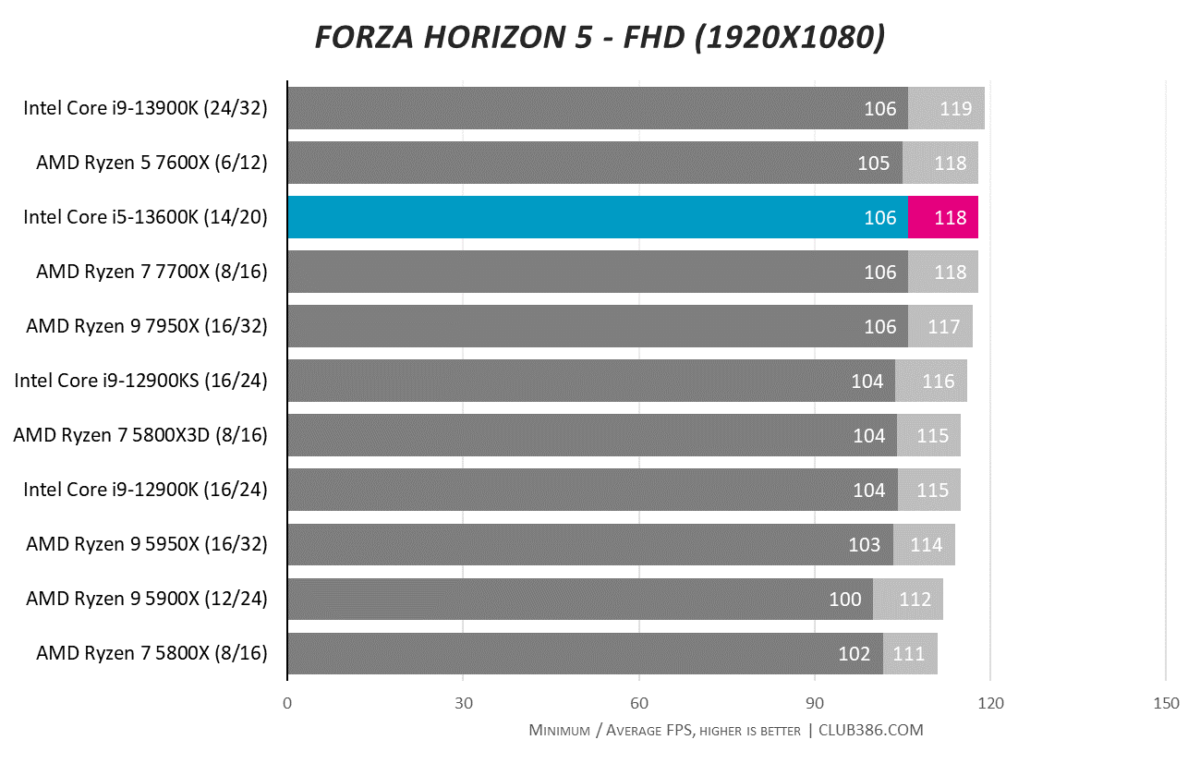
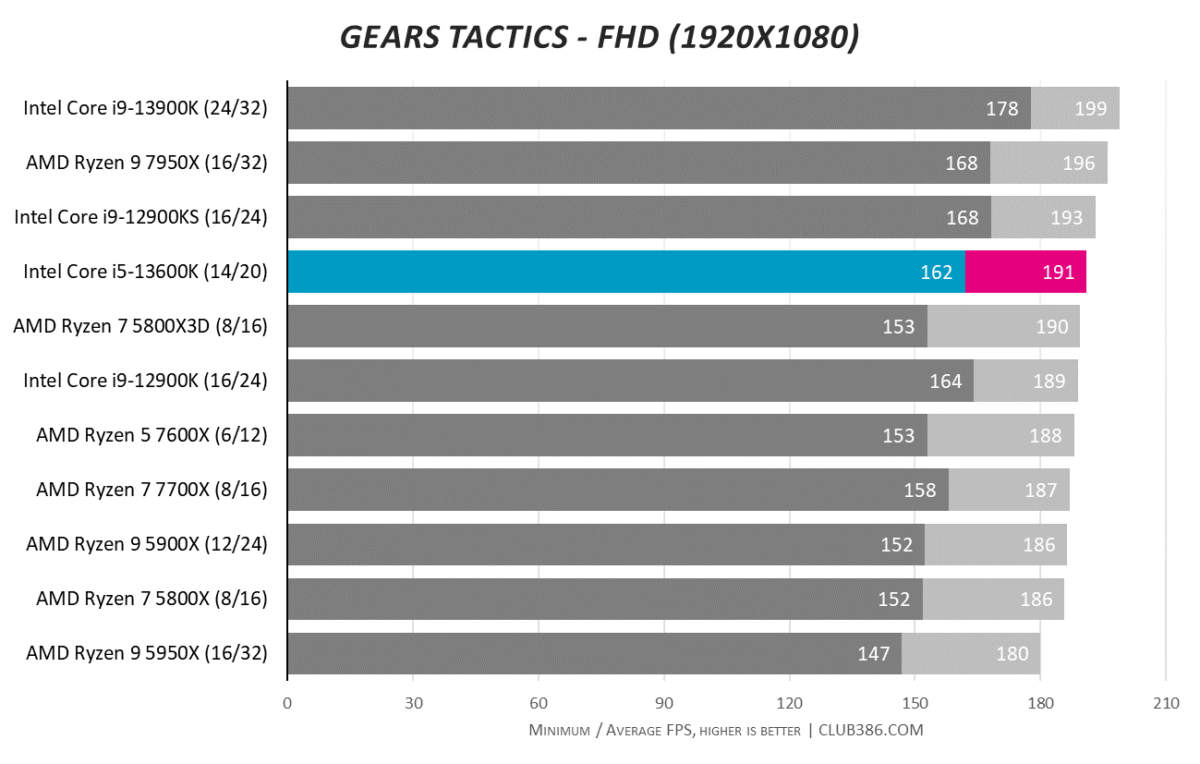
Gears Tactics is the only title to give AMD some respite from the constant barrage instigated by mid-range Raptor Lake.
Power, Temperature, Efficiency, Value
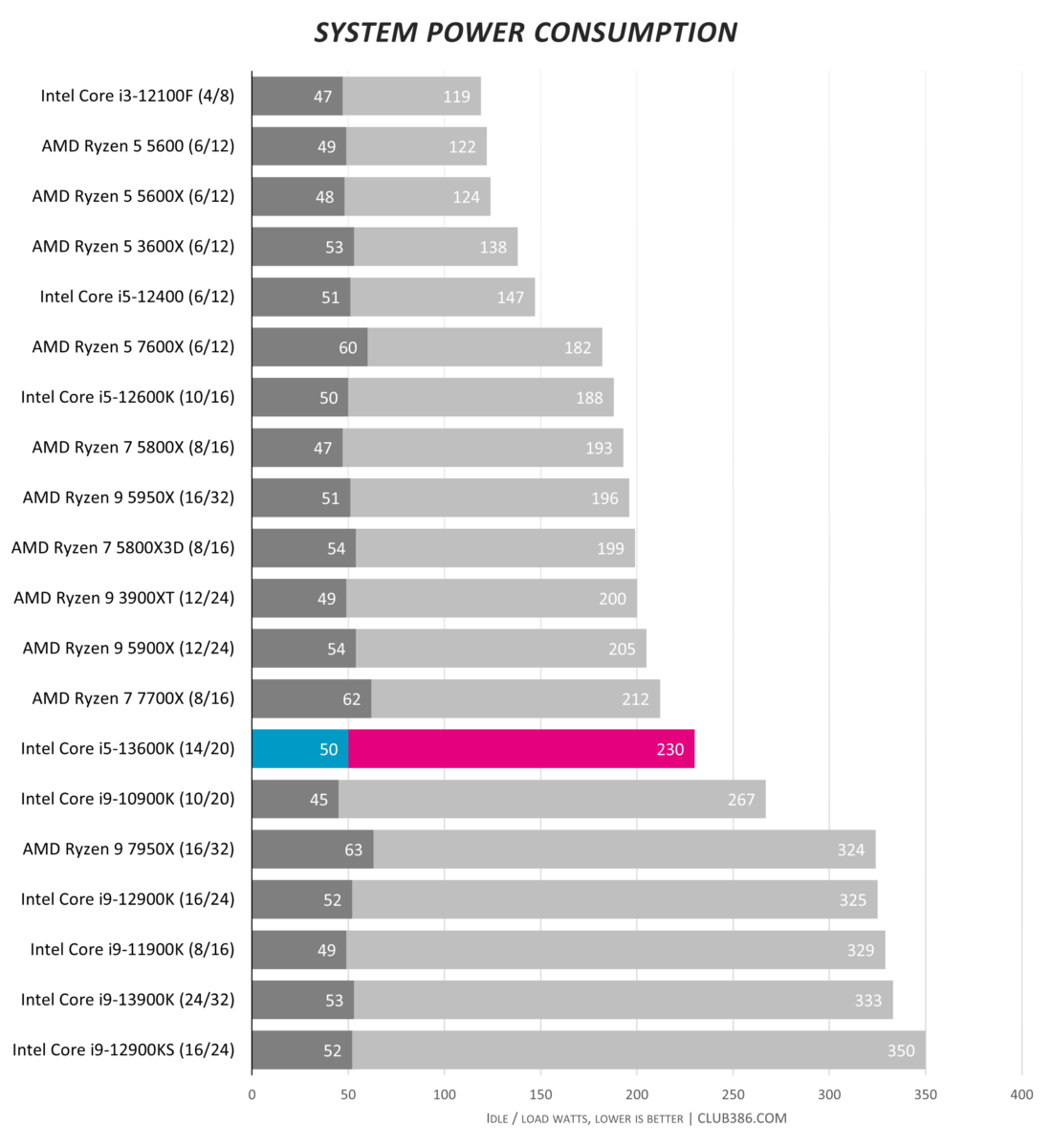
Analysis shows Intel achieves higher frequencies this generation by adding more coal to the fire, which is enough to ensure the all-core speed consistently hovers at peak 5.1GHz for performant P-cores.
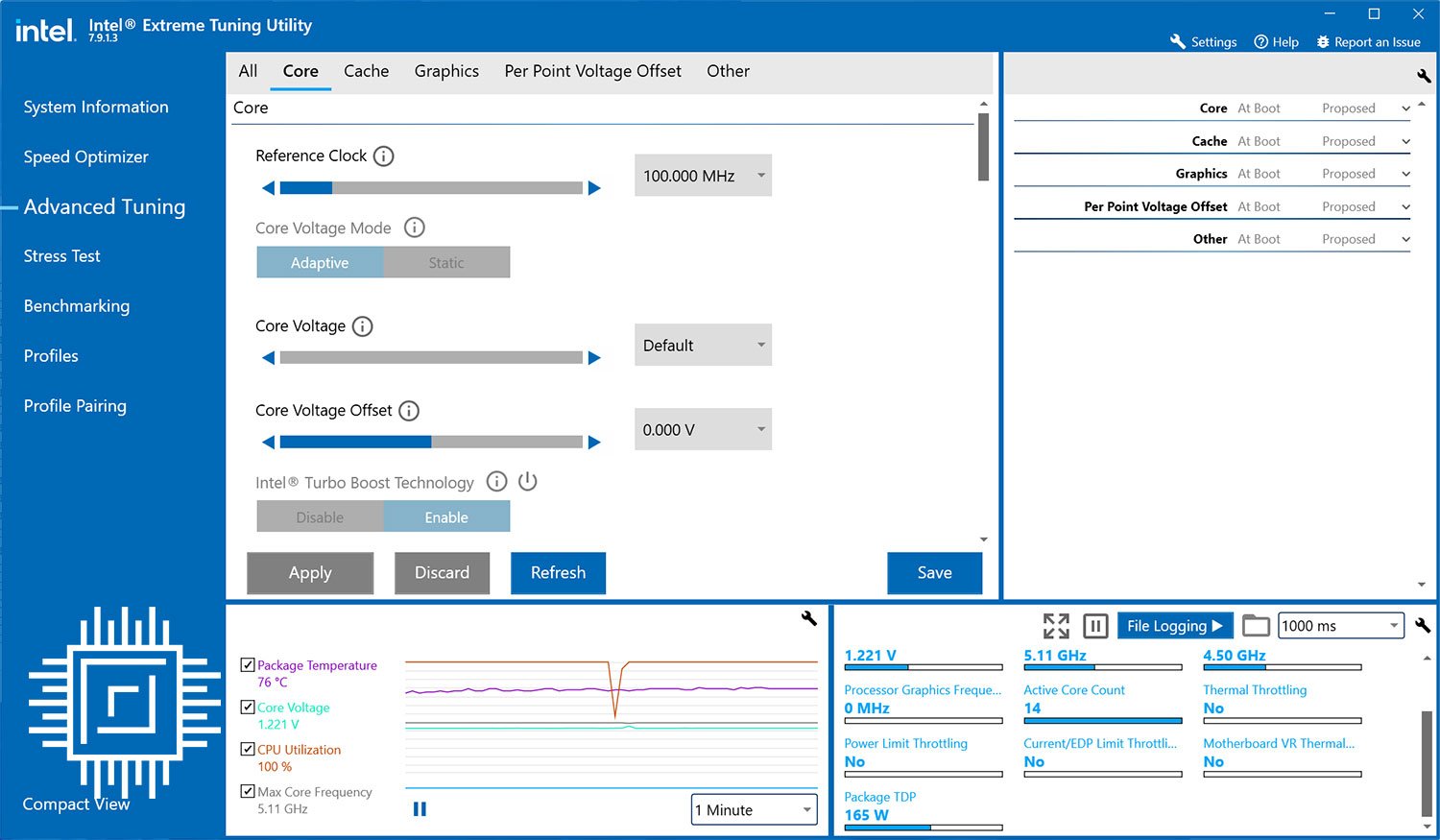
In fact, for most multi-core benchmarks the chip doesn’t need to scale to the upper limit of 181W. Applications such as Cinebench, Geekbench and even Blender chug along fine at an all-core 5.1GHz by using no more than 165W package power.
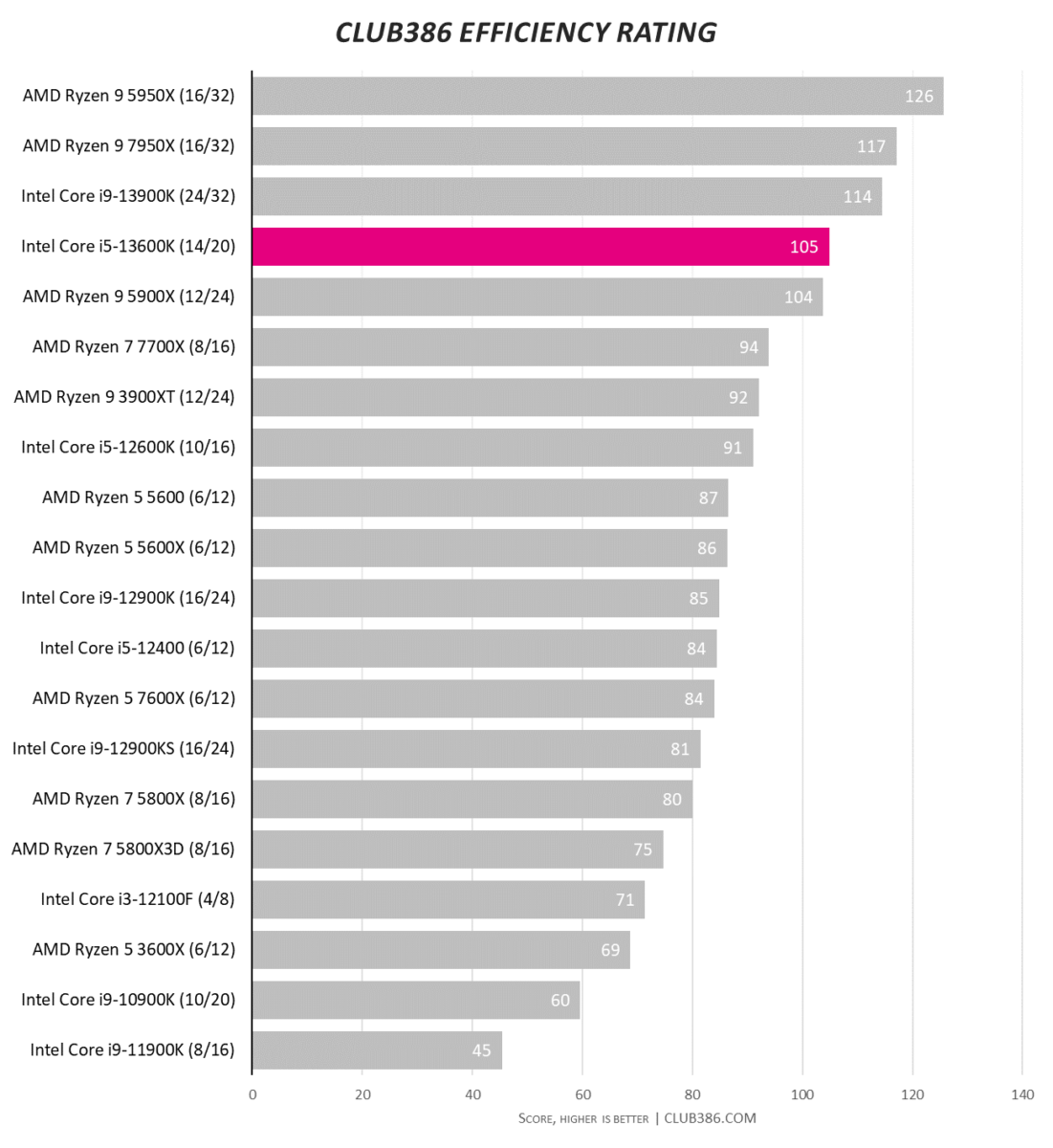
Having splendid multi-core performance and relatively restrained power can only mean one thing: a high placing on the efficiency chart that divides observed Cinebench R23 multi-core score by system-wide power consumption.
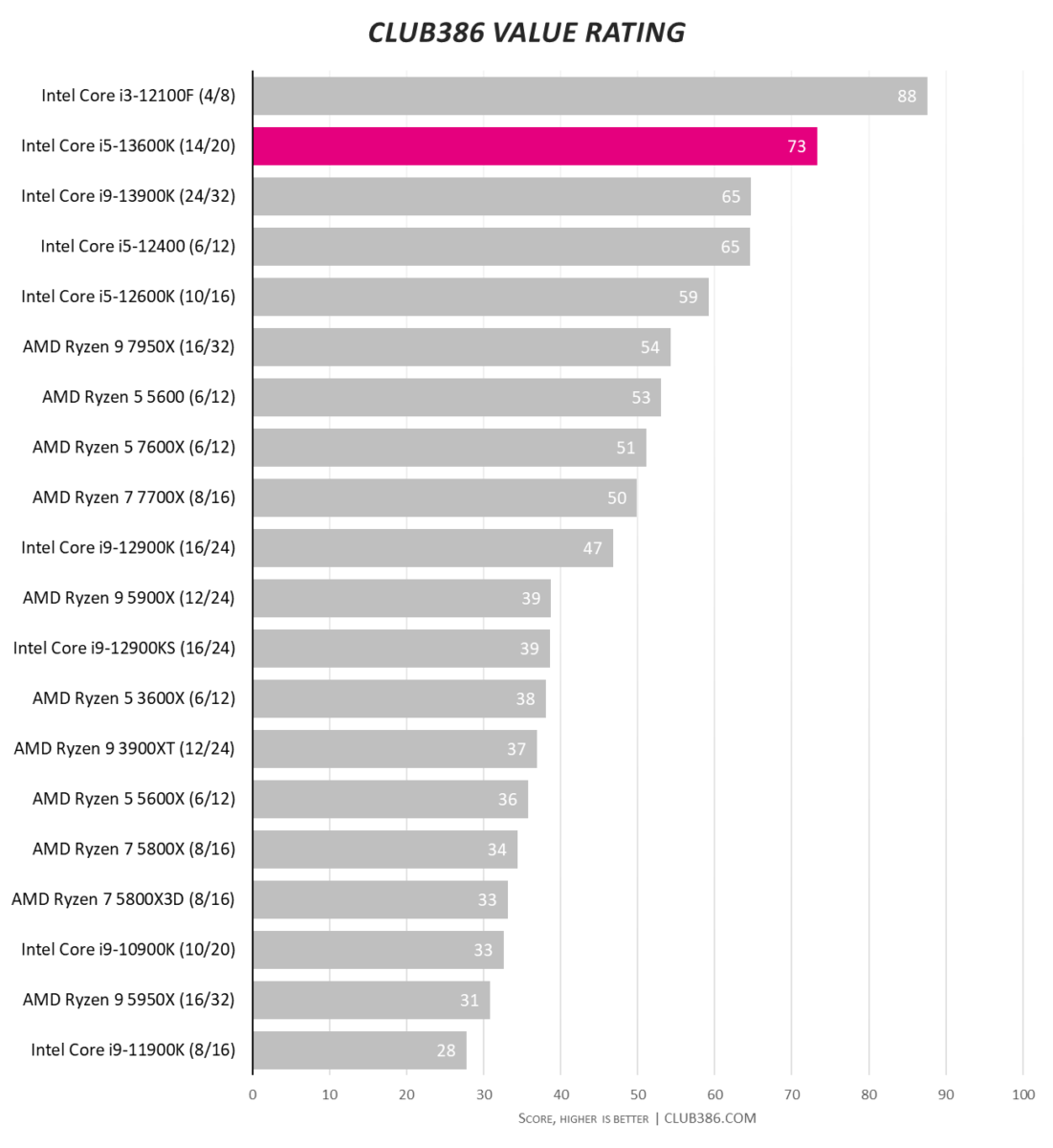
Moving up from fourth spot on the first graph to second here – which divides the same Cinebench R23 score by recommended dollar price – Core i5-13600K continues to impress.
Overclocking
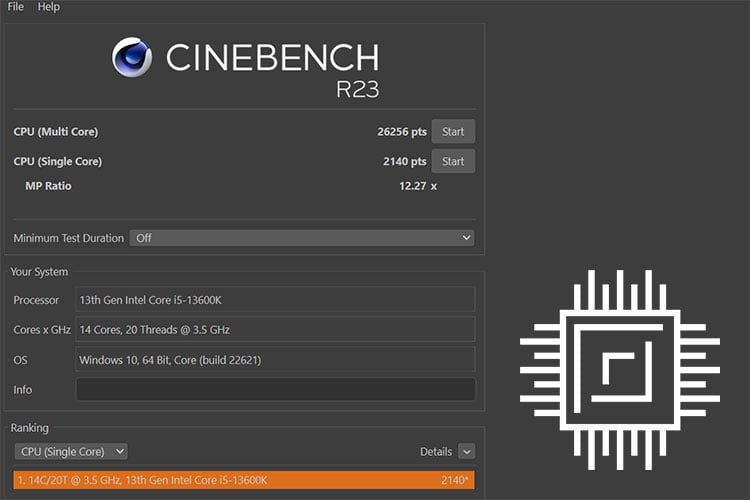
Already muscular in out-the-box state, pushing farther never hurt anyone. Disabling CPU power limits and adding 0.075V for both P- and E-cores results in final, stable frequencies of 5.5GHz and 4.3GHz, respectively.
Multi-core performance approaches that of a Core i9-12900KS, and gaming results improve enough to dust any 12th Gen Core and, more importantly, Ryzen 7000 Series CPU.
Conclusion
Let’s cut straight to the chase. The $319 Intel Core i5-13600K is a fantastic processor which belies mid-range branding to post superb results in applications and gaming alike.
Building on the last generation by bulking out in all the right areas, Intel hits hard where it counts most. Rival AMD’s nascent Ryzen 7 7700X and Ryzen 5 7600X are taken to task in practically every scenario, and adding the cherry on top, Intel softens the blow to adoption by providing compatibility with inexpensive B660 motherboards and common DDR4 memory.
Striving for excellence in every area, the mid-range champ renders most 12th Gen chips redundant. Anyone having purchased a Core i9-12900KS will be left with a rueful smile, wondering how an i5 is able to beat their prized CPU in gaming.
Behaving like the best Cores of 2021 and giving price-comparable Ryzens a bloody nose, Intel has a real gem in Core i5-13600K. The one to go for.
Verdict: A brilliant processor offering oodles of performance for a little over $300, Core i5-13600K is a no-brainer.

